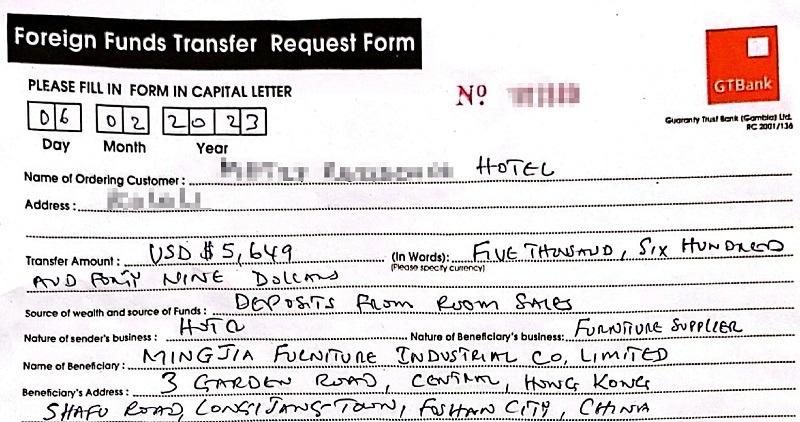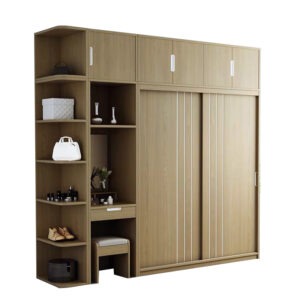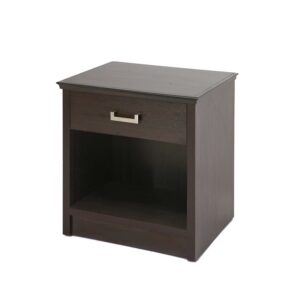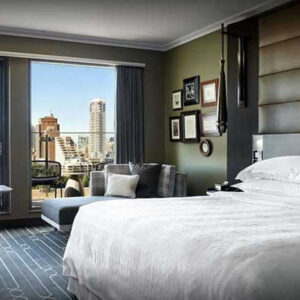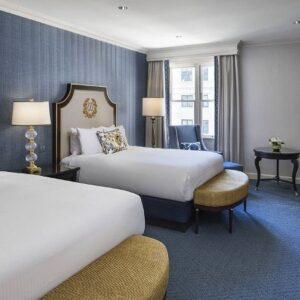As a professional furniture supplier in China, we often receive inquiries from new customers consulting how to import furniture from China. Some have never imported from China before, and some have bought non-furniture products from China before, so today, we write in detail about how to import furniture from China. Before buying furniture from us or any other furniture suppliers in China, you can check this article.
This article covers almost all the details of importing furniture from China, and you can still learn from it even if you have already imported furniture from China many times. Let’s begin!
About China Furniture
We could give you a lot of statistics, but we want to break down China and its furniture manufacturing in a few sentences.
Believe it or not, China is still the biggest furniture production site. While there are several countries also famous for furniture manufacturing and export, such as Italy, Turkey, Poland, Vietnam, Malaysia, and Mexico, they do not have the infrastructure that China does.
Imagine you need a full set of furniture, sanitary items, household appliances, lighting, carpet, flooring, and ceramic. You walk into a Wal-Mart. You can find practically anything you need within 10,000 square feet. That sums up China’s infrastructure.
Factory A provides beds and wardrobes, Factory B provides outdoor rattan furniture, Factory C provides raw materials and furniture hardware, and Factory D provides packing materials for all kinds of furniture. They are all within a stone’s throw away from each other in China’s furniture industrial zones. Most of the furniture factory bosses are related to each other. They set up a perfect system within their “furniture community.”
There are many furniture manufacturers and factories in China, and you can find any kinds of furniture here, but most furniture manufacturers and factories are only specialized in certain types of furniture. It is impossible to find one who can make all kinds of furniture by himself. For example, some small China furniture factories only supply office chairs, and some only make classic designer furniture such as eames lounge chair and Barcelona chair.
But not all China furniture manufacturers are in one city, and there are some famous furniture areas and towns in China. Each has its own type of furniture, and we will make a list in later sections. However, nowadays, furniture production in China is also shifting inland to take advantage of lower labor and production costs.
Why Import Furniture from China
There are two main reasons why you should import furniture from China.
Reason No.1: Margin is made in purchasing, not selling.
Every successful buyer in the world who works for a larger company will tell you that it’s all about the purchasing. Profits are made when buying and not selling.
Yes, sure, there is a profit to be made in selling furniture, but what if you are one of many selling this kind of furniture? There would be many competitors to bid for a contract furniture project. Then you have to work for your margin at the root rather than when selling furniture products. The competition doesn’t sleep – they spend their time researching the price. If they match or even lower their price, you have a problem. You have to decide if you want to accept a loss in the margin or look for a new supplier. And you don’t want to go to your importer for that. You go to the source directly, and that’s the furniture manufacturers and factories in China.
Case Study: Eames Lounge Chair Replica
You must know design master Charles Eames and his classic Eames Lounge Chair, which is currently sold by Herman Miller in the US, and let’s have a look at Herman Miller’s prices:
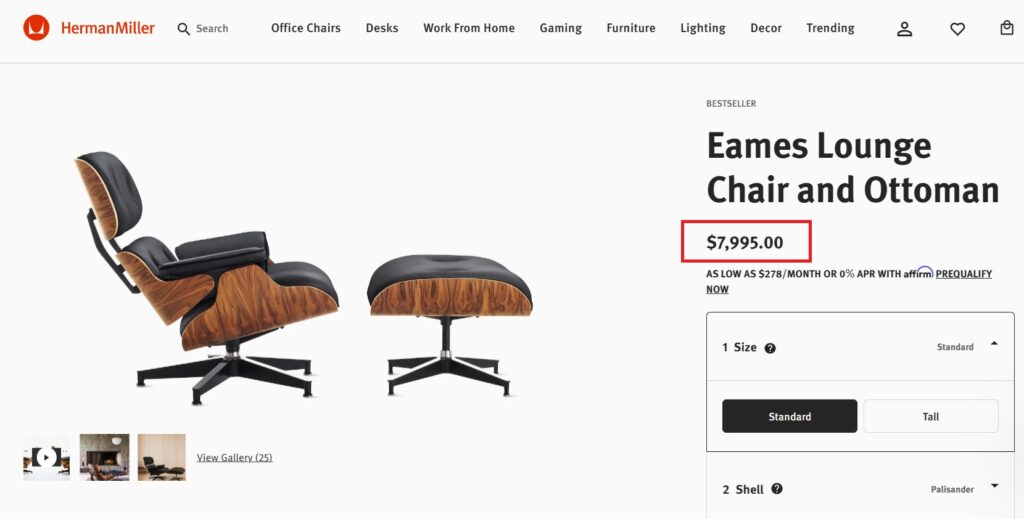
It’s expensive, isn’t it? Now let’s have a look at the price of eames lounge chair replica in China:
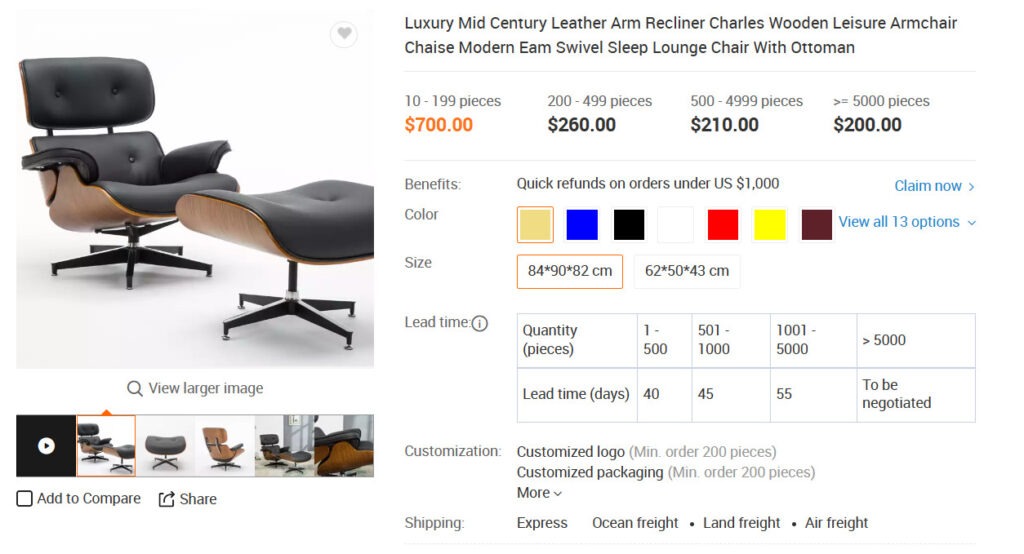
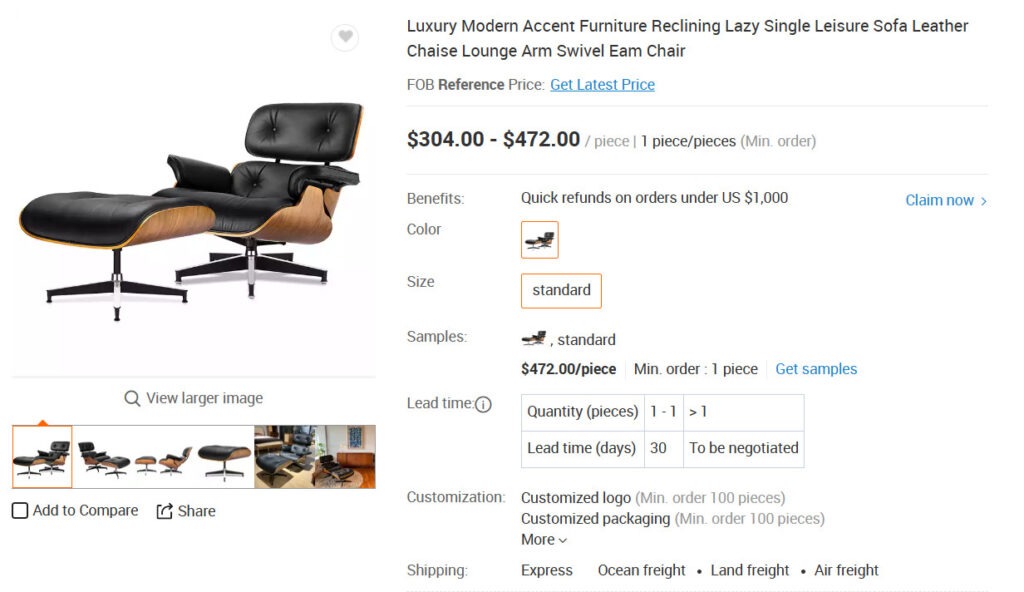
Amazing? One China furniture suppliers can even accept 1pc MOQ order! You can try to figure out the profit of importing a 20GP container of Eames Lounge Chairs (about 50 pcs) from China and selling it in your local area.
However, please note that Herman Miller has the copyright of eames lounge chair, so please consult a lawyer before importing this lounge chair to avoid legal trouble.
If you are interested in this lounge chair, pls click our product page Eames Lounge Chair Replica.
Reason No.2: Innovator effect.
Say your competitor buys the same or similar furniture product to what you have, probably from the same source (your importer). You don’t want that. You want great furniture products with a significant margin, so you have to be the first to find them and make a deal with the furniture manufacturer to have them exclusively. And the only way this is done is by visiting China and going to furniture factories to see their furniture products and discuss details face to face.
Advantages of importing furniture from China
- Low furniture manufacturing costs.
- China furniture suppliers are much more open to working with smaller businesses and providing smaller quantities.
- Large number of furniture suppliers to choose from.
- For some furniture products, China might be the only place that produces the item.
- One-stop services like Alibaba, Globalsources, and Made in China have made it easy to navigate and purchase from China furniture manufacturers and factories.
- China is effective in furniture production and infrastructure. You can buy relative products such as ceramic, flooring, lighting, carpet, windows, and doors together with furniture in China, then ship all items in one or several containers.
Disadvantages of importing furniture from China
- Perceived lower-quality of furniture products.
- (Usually) lower furniture manufacturing and labor standards.
- Almost no intellectual property protection.
- Language and communication barriers can be difficult to overcome.
- Difficult/costly to visit China furniture manufacturers on-site (especially during the COVID-19 pandemic).
- Longer shipping time (if you are far away from China).
- Cultural differences in business practices.
- Product importation and customs clearance.
- Lower level of payment security and less recourse if something goes wrong.
However, this guide will take away these fears and disadvantages and prepare you for a trouble-free import.
The 7-step Furniture Import Process
Here is the general outline of the process. We will look into each step in greater detail in later sections. It is also the same process whether you go to China or sit in the comfort of your home.
These are the 7 steps you always need to follow regardless of what kind of furniture product you want to import.
1) Decide where your furniture product will be manufactured.
Countries have different export/import regulations. While furniture products may be cheap to buy from China, many other factors might add costs. Requirements for importing specific commodities depend on a wide variety of criteria. Some information, such as whether a furniture product is subject to quota restrictions, eligible for reduced rates of duty, or restricted from entry because it originates in an embargoed country, can be determined only if you know the item’s Harmonized Tariff customs number, which can be found for the U.S., for example, under: http://hts.usitc.gov/.
If you live in Europe or any other country, Google “customs tariff number (your country)”.
Click on the link and head to the country’s official government website.
You can look for a furniture product’s tariff or regulation information on these databases.
You can also try https://simplyduty.com, which gives you five free chances to look up information. The rest is premium and paid services. It’s a great way to find out all the costs of taxes and customs fees you must consider.
At these sites, you will also find a lot of tips on items that have “anti-dumping” tax on them to minimize the import and protect the local industry. For example, when importing wood bedroom furniture from China, the U.S. importer would have to pay heavy anti-dumping duties if the Chinese exporter was not on the low-tariff list.
2) Find the furniture products you need
Before importing from China, you must be clear about what kind of furniture products you need. Different business models will have different furniture needs. Some customers need imported furniture to sell in their local furniture stores or on Amazon / eBay. Some customers may need custom furniture and relative products from Chinese suppliers to finish their projects, such as hotels, villas, restaurants, apartments, etc. We will go into this in more detail later.
3) Find furniture manufacturers and suppliers in China
This is the most exciting but also the most challenging part. We will go into this in greater detail later. If you are new to importing, there is usually a lot of support from your local government, which is ready to answer your questions. But the purpose of this article is to help you to understand the process by yourself.
4) Calculate all duties and taxes
This goes hand-in-hand with the first part of the process. Import duties can be calculated in different ways and can make or break your business.
Here is a rule of thumb: You can take the buying price from my furniture supplier and add 20-30% on top. This would give you a rough idea of the landing price. This rule applies to first-world places like the U.S., Europe, Canada, Hong Kong, and Singapore. Many second or third-world countries are not so open to importing and put a high percentage of duties and taxes on top of import products to protect the local industry.
Many first-world countries have 0% duties and taxes to encourage imports. You can check for more information using Customs Tariff Numbers (see above) or resources like www.simplyduty.com. We will go into this in a later section.
5) Find a freight forwarder and customs broker
Most furniture items are big in volume, so sea transportation is the primary shipping way if you import furniture from China, or the shipping cost is much more expensive, and there is no need to import from China.
You will need a freight forwarder to make a quotation for the sea freight and arrange the sea shipping from China port to your local port.
You will also need a customs broker (usually, this company is near your local port) to do the rest jobs after the containers have arrived at your port. They would clear the custom and deliver the containers to your warehouse by truck.
Different incoterms (usually EX-WORK/FOB/CIF/DDP), different costs, we will cover more details later. Don’t do this process (logistics) yourself. It can be a nightmare, trust me.
6) Negotiate with the suppliers and confirm the order
When you get quotations from furniture suppliers in China and know the cost of shipping, duties, and taxes, you can figure out the profit of this order. Try to negotiate with the suppliers if the profit is unsatisfactory, but remember to check all details such as furniture material, quality assurance, incoterm, delivery date, payment term, etc., first.
You can confirm the order if everything is OK, but there are still lots of things to do after that. We will cover more details in a later section.
7) Monitor your shipment and have an inspection.
If you have a larger shipment or valuable products, you NEED to hire a third party for inspection. This third party can inspect your shipment during or after production and send you a report. Based on this report, you can give the supplier the release of the shipment or have him REWORK your goods. If there are problems found during your inspection, the supplier will ALWAYS agree to rework your shipment because he is still waiting for the rest of his money, which you will only release to him once you are happy with your shipment (do not pay 100% of your order up-front, EVER).
Once you let your supplier know that you will inspect your furniture products, he is more likely to pay more attention to your order. And the best part? This inspection can be done for ~300 USD from companies like Asia-Inspection, TUV, Bureau Veritas, and many more.
How to Find the Right Furniture Products from China?
As mentioned earlier, this can be a lengthy or very short process if you already have something in mind. Just skip this part if you have already gotten full details of furniture requirements from your customers. We will give you a few ideas and guidelines if you don’t have any furniture product ideas yet.
1) Choose furniture products from China suppliers’ catalogues.
This is the fastest way to have a furniture product idea, contact some suppliers and ask for furniture catalogue (PDF version). Most suppliers would be happy to send their catalogues, and you can find many furniture products in their catalogue, and choose the one you are interested in, then check if it is worth importing from China.
The problem is that most catalogues from China suppliers are outdated, the furniture models in the catalogue may have been on the market for several years, the competition is stiff, and your profit may not be great.
2) scouting the Internet and looking at trendy websites.
This is one of the best ways to find new furniture products. For example, this link provides all the necessary company websites: http://www.kadaza.com/.
Just click on the Home & Garden category, then you will find many major furniture websites provided. For example, click “Office furniture”(home office products have been very hot since the COVID-19 pandemic in 2020), and you will find the top 24 websites where you can start your research on the office furniture that you would like to import. It is time-consuming but also a great way to find ideas and potential scout competitors.
3) Furniture Newsletters
You can also subscribe to at least 100 newsletters of furniture companies that provide good furniture products. This way, you get weekly newsletters of trending furniture products. Go onto a company’s website and subscribe, easy as that. It could be your local furniture chain stores, a big furniture brand name company, or some interior design blog that consistently features the best and newest furniture products.
Perhaps you could create a new email address that you register with on these sites so that your main (work) email address doesn’t get overwhelmed with newsletters.
4) Furniture exhibitions / fairs (NOT only in China)
There are hundreds of furniture exhibitions each year in many countries. You get to meet the furniture supplier, see the furniture products and talk over details such as prices, models, and much more. On top of that, we guarantee you will get inspired.
To find furniture exhibitions near you, Google the exhibition center near you and get your entry ticket. You can also try famous international furniture fairs such as High Point Market, Salone del Mobile, and Imm Cologne. Most times, you will need to provide name cards and contact details for that. You can order business cards for $5 these days. Going to an exhibition prepared and with a professional image gives the supplier a great impression of you. We will cover furniture shows and how to behave there in a later section,
5) Amazon & eBay
Amazon and eBay can help you get started on basic product ideas. We don’t recommend starting by importing furniture products that the majority of companies already have. But these websites give you significant input on trends and items that sell well.
Ensure that the furniture product you want to import is not regulated or restricted in your country. Do your research!
Validate Your Furniture Product Idea
You can skip this section if you already have a contract furniture project and need custom furniture from China.
You’ve found your furniture product, GREAT! But be careful, don’t get over-excited about a product you just saw or had an idea for. You must first evaluate if your furniture product fits the market and its consumers.
We call this “product-to-market-fit,” meaning you have something that the market needs.
To evaluate your furniture product, you should go through the following steps:
1) Cost details of furniture products:
- Cost of furniture manufacturing in China. You can get it directly from the quotations sent by China furniture suppliers.
- Cost of transport. This can be crucial to your margin if the transport cost is very high. Most furniture importers load their China furniture products in containers and then ship them by sea, and sea freight has increased significantly since the pandemic in 2020 (but it starts to fall in 2023, good news).
- Cost of duties and taxes.
- Possible profit before tax.
2) Competition of furniture products:
- Make sure no one or not many people carry your furniture product. It’s worth noting that classic designer furniture (e.g., Egg Chair) is very popular and easy to sell, but the competition is stiff.
- Analyze the market, and do your research. Look at social media hashtags.
- Test the idea with a few furniture-related forums (but don’t give away too much information).
- Research trends on furniture blogs or interior design sites.
Ways to Furniture Sourcing in China
there are generally four practical ways to source furniture products in China:
- B2B Platform in China (Alibaba and Made in China)
- Search Engine (Google and Bing)
- Exhibitions / Conventions
- Contacts
- Visit famous furniture cities and towns in China
Let’s check these four ways one by one in detail.
1) B2B Platforms (Alibaba and Made in China)
The Internet is the fastest way to source furniture products from China. There are hundreds of providers on the Internet to source products.
The most reliable and efficient ones would be:
ALIBABA (B2B-Business to Business for larger quantities)
MADE IN CHINA (B2B and Marketplace) Alibaba’s competitor in China
We recommend using Alibaba and Made in China since they have been around the longest and are the safest to use.
There is also a platform called Aliexpress, which belongs to Alibaba, focusing on B2C (Business to Consumer) for small orders and drop shipping, but this platform is not suitable for sourcing furniture because most furniture items such as sofas, beds, and wardrobes are in large volume, the shipping cost would be very high if you buy one or two sets furniture from Aliexpress,
There are many other websites within China similar to those two sites, but they are not as user-friendly and safe.
2) Search Engine (Google and Bing)
Not all China furniture suppliers and manufacturers are in Alibaba or Made in China. The annual membership charge and extra fees for ranking Top 10 of manufacturers’ main furniture products in these platforms increase yearly. And there are lots of limitations on these platforms if you only pay for a basic membership.
Google also made a big update on the algorithm in 2021, organic search traffic of these products platforms has reduced a lot, so some excellent China furniture suppliers and manufacturers have started to market with their company websites. You can’t find them in Alibaba or Made in China, but you can find them by searching “sofa China” or other China furniture related keywords in Google and Bing.
Google is smart now. If they put some furniture websites on the top of your search result, that means these furniture companies in China are okay, at least they pay attention to their websites and know what the customers need, right?
Try to use different keywords in Google or Bing to find your best furniture suppliers in China. You can find contact details easily on these furniture suppliers’ websites, then send your requirement via Email or Whatsapp if it is hard to explain in a phone call. Please also note that Google has been banned in China for more than 10 years, so you need VPN to use all Google services (including Gmail and Youtube) in China. You can also try Bing if you don’t want to set VPN.
Why not Baidu (The biggest search engine in China)? Because the English version of Baidu is not good, you need to find a translator to search in Baidu, and there is a lot of spammy advertisement in Baidu, which would waste lots of time.
3) Furniture Exhibitions / Fairs
Furniture exhibitions are the most effective way to find furniture suppliers and products since you meet face-to-face and can also check furniture samples in their showroom.
As a first step, Internet sourcing is fine, but try to arrange your next China trip around an exhibition. You don’t want to place a large order (furniture is not a cheap product and usually takes a large volume) without knowing what you will get. You wouldn’t want to place an order with someone you never met and transfer a lot of money to him. So going to exhibitions helps a lot.
There are many furniture exhibitions and fairs in China every year, CIFF (China International Furniture Fair) Guangzhou and Shanghai is the most famous furniture fair in China. It was difficult to visit China because of the strict China official policy for the COVID-19 pandemic since 2020 (you need to be locked down in a China hotel for 2 weeks after getting off a plane at any China airport). These China furniture fairs had been affected a lot, some China furniture suppliers and manufacturers had chosen to attend furniture exhibitions in Asia (such as Malaysia, Vietnam, and Singapore) to attract more new customers in recent years.
But China canceled the strict entry policy in Dec 2022, so you can visit China furniture fairs freely in 2023, but pay attention to some small furniture fairs. They may be for China domestic furniture market only, and it may be hard to find someone who speaks English there!
We have to mention Canton Fair regarding the international fairs in China. The Canton Fair is the holy grail of exhibitions. This event is so significant that it is held twice a year, and each time runs for 3½ weeks in three different phases. Each phase comes with different product categories. As of 2016, there were over 26,000 exhibitors. You will find a lot of innovations, big brands, small factories, or the product you have been looking for for so long.
The Canton Fair was held online during the pandemic, but it would soon back to normal in 2023 since China had canceled the strict entry policy in Dec 2022.
4) Contacts
Last but not least, contacts that you already have can be very helpful. Ask around in your friend circle, relatives, and so on. You never know, your sister’s cousin might have a contact that you didn’t know about.
Sign up on business networks such as www.linkedin.com if you haven’t already. You can find a lot on there and can ask around if anyone has any contacts to suppliers for your furniture products.
There are also professional groups on Linkedin, with many furniture suppliers offering their products and services. Search for a group that could meet your needs (e.g., China sofa suppliers/custom furniture manufacturers, etc.) and post your inquiry to this specific group.
If you aren’t on any business networks or have no contacts, we recommend starting with Alibaba/Made in China.
Usually, government agencies in your country will also provide you with supplier contacts. But be aware most of these contacts will likely be importers themselves. You will want to cut them out and go to the source in China. Remember, that’s what this article is all about.
5) Famous furniture cities and towns in China
China has a vast territory, and not all furniture products are made in one China city. Some cities and towns are famous for one or two types of furniture. China National Furniture Association has listed 37 famous furniture industry areas in China. You can check the list below and visit these places if you are interested in their furniture products. This is the real source, and you will get the best price with good quality. Many furniture sourcing or trading companies in China also buy furniture products from these furniture zones.
| No. | Date | Name | Location |
| 01 | March 2003 | China Mahogany Furniture Production Professional Town | Dayong Town, Zhongshan City, Guangdong Province, China |
| 02 | August 2003 | Home of China Chair Industry | Anji County, Huzhou City, Zhejiang Province, China |
| 03 | March 2004 | China Furniture Trade Business Center | Lecong Town, Shunde Area, Foshan City, Guangdong Province, China |
| 04 | August 2004 | Home of China Tables and Chairs Industry | Ningjin County, Dezhou City, Shandong Province, China |
| 05 | September 2004 | China Furniture Export No.1 Town | Dalingshan Town, Dongguan City, Guangdong Province, China |
| 06 | July 2005 | West China Furniture Trade Business Center | Wuhou District, Chengdu City, Sichuan Province, China |
| 07 | August 2005 | Chinese Furniture Manufacturing Town | Longjiang Town, Shunde Area, Foshan City, Guangdong Province, China |
| 08 | August 2005 | China Furniture Materials Trade Business Center | Longjiang Town, Shunde Area, Foshan City, Guangdong Province, China |
| 09 | September 2005 | China Metal and Glass Furniture Industry Base | Shengfang Town, Langfang City, Hebei Province, China |
| 10 | December 2006 | China Solid Wood Furniture Industry Base | Zhuanghe City, Liaoning Province, China |
| 11 | March 2007 | North China Furniture Trade Business Center | Xianghe County, Langfang City, Hebei Province, China |
| 12 | May 2007 | China European Style Classical Furniture Production Base | Yuhuan City, Taizhou City, Zhejiang Province, China |
| 13 | January 2008 | China Traditional Furniture Professional Town | Dajiang Town, Taishan City, Guangdong Province, China |
| 14 | May 2008 | Famous Town of Chinese Classical Furniture | Sanxiang Town, Zhongshan City, Guangdong Province, China |
| 15 | June 2009 | East China Furniture Trade Business Center | Likou Town, Zengxiang District, Suzhou City, Jiangsu Province, China |
| 16 | December 2009 | China National Wood Carving Furniture Industry Base | Jianchuan County, Dali City, Yunnan Province, China |
| 17 | April 2010 | China Panel Furniture Industry Base | Chongzhou City, Sichuan Province, China |
| 18 | April 2011 | China Sofa Industry Export Base | Haining City, Zhejiang Province, China |
| 19 | June 2011 | China Central Furniture Industry Base | Nankang City, Jiangxi Province, China |
| 20 | July 2011 | Classical Chinese Furniture Cultural Industry Base | Yangxin County, Binzhou City, Shandong Province, China |
| 21 | July 2011 | North China Furniture Export Industry Base | Ducun Town, Jiaozhou City, Shandong Province, China |
| 22 | July 2011 | China Central Furniture Industrial Zone | Qianjiang City, Hubei Province, China |
| 23 | July 2011 | Chinese Zhangwu New Furniture Industrial Zone | Zhangwu County, Fuxin City, Liaoning Province, China |
| 24 | April 2012 | China Metal Furniture Industry Base | Zhangshu City, Jiangxi Province, China |
| 25 | April 2012 | China Office Furniture Industry Base | Hangzhou City, Zhejiang Province, China |
| 26 | October 2012 | Home of China Vanity Industry | Dangshan Town, Xiaoshan District, Hangzhou City, Zhejiang Province, China |
| 27 | November 2012 | China Su Mahogany Furniture Town – Haiyu | Haiyu Town, Changshu City, Jiangsu Province, China |
| 28 | November 2012 | China Su Mahogany Furniture Town – Bixi | Bixi Town, Changshu City, Jiangsu Province, China |
| 29 | December 2012 | China Furniture Hong ‘an New Industrial Zone | Hong ‘an County, Huanggang City, Hubei Province, China |
| 30 | December 2012 | Southwest China Furniture Industry Base | Xindu District, Chengdu City, Sichuan Province, China |
| 31 | April 2013 | China Ruili Mahogany Furniture Industry Base | Ruili City, Yunnan Province, China |
| 32 | April 2013 | China Xianyou Mahogany furniture industry Base | Xianyou County, Putian City, Fujian Province, China |
| 33 | August 2013 | China Carving Rosewood Furniture Center | Dongyang City, Zhejiang Province, China |
| 34 | August 2013 | East China Furniture Industry Base | Hai ‘an County, Nantong City, Jiangsu Province, China |
| 35 | 2014 | China Zhongyuan Furniture Industrial Zone | Yuanyang County, Xinxiang City, Henan Province, China |
| 36 | 2014 | Jing Chinese Classical Furniture Industry Base | Laishui County, Baoding City, Hebei Province, China |
| 37 | 2014 | China Steel Furniture Industry Base | Pangcun Town, Luoyang City, Henan Province, China |
Alibaba Furniture Sourcing
If you don’t have contacts, the easiest way is to start sourcing furniture suppliers at www.alibaba.com or www.made-in-china.com. We will introduce Alibaba first, Made in China is similar to Alibaba, and we will go into it in a later section.
Alibaba is relatively simple to use. You create an account, fill in your company information and details, and then you can start sourcing right away.
You can filter by furniture products or suppliers. Nowadays, it’s safe to use Alibaba. Most furniture suppliers are pre-assessed by Alibaba through document checking, phone calls, and various other methods. Some suppliers even have on-site checks, which means that a third party did a factory audit, and you can download that audit in PDF format.
Alibaba has many other excellent functions, such as filtering by country or region. Say you plan on going to Foshan or Guangzhou in China, you can narrow down the province in filters (in this case, it is Guangdong province), so you only see suppliers from that region. It would save you lots of time, or you need to check suppliers’ areas one by one.
1) Begin your furniture sourcing on Alibaba.
This is pretty straightforward. You can browse two options, products and manufacturers.
We will start with products since we assume we don’t know any China furniture suppliers.
You can type the furniture product name in the search bar or move your mouse to the furniture category under “My markets” on the left, Alibaba will show more detailed furniture products to check.
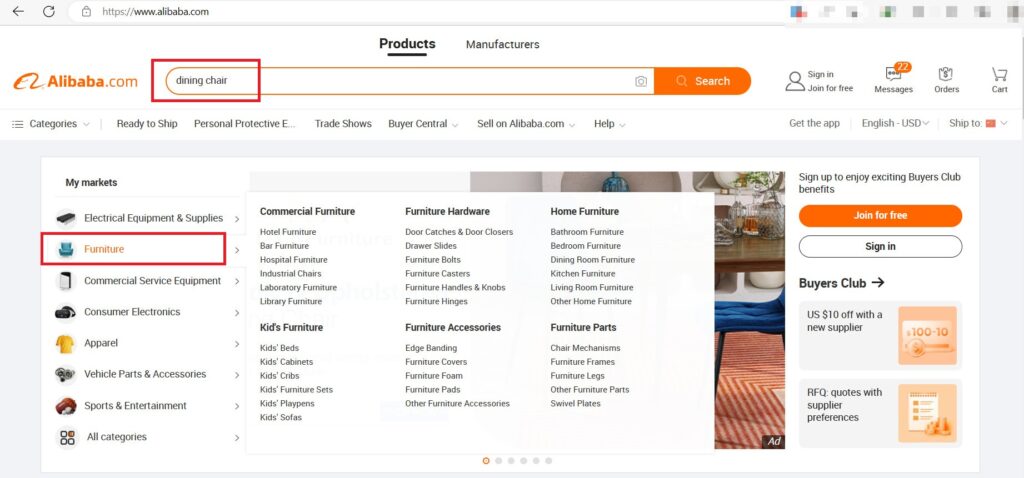
Let’s click the first product, “Hotel Furniture” under the commercial furniture category, Alibaba would show many hotel furniture products such as hotel chairs, hotel bedroom sets, hotel beds, hotel sofas etc. Remember, many results are duplicates because of multiple entries by the same furniture supplier. Also, you will often find that popular and openly available products are offered by different furniture manufacturers and suppliers in China.
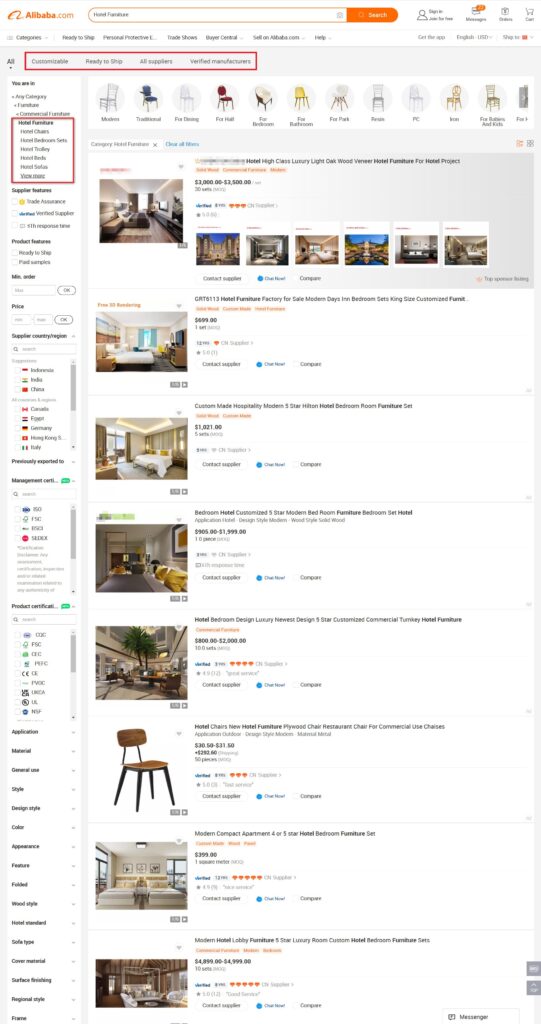
You can see that there are four menus at the top of the search result in bold font: Customizable, Ready to Ship, All suppliers and Verified manufacturers. Just check the part you are interested in.
For example, click “Verified manufacturers” if you would like to buy only from hotel furniture manufacturers, then you can see many furniture factories on the result page. Are they all real China furniture manufacturers? Not all, some furniture trading companies would cooperate with furniture factories, they can easily get Alibaba verified and assessed if the furniture manufacturers do their best to help.
But there’s no point in dwelling on it, and you may not get the best price even if you find the actual furniture manufacturers and factories in China. Furniture trading/sourcing companies have their USP (Unique Selling Proposition), which we will explain later.
Moving on, let’s check “Ready to ship”. You can see many chairs and sofas with simple or classic designs on this page. Most of these products are furniture stock, and they can be shipped fast if you only need minor changes, such as replacing upholstery fabric. You can also see some hotel guest room furniture sets on this page, but they are usually custom furniture, no suppliers or factories would make stock for it because they only know how many furniture sets you need once you contact them.
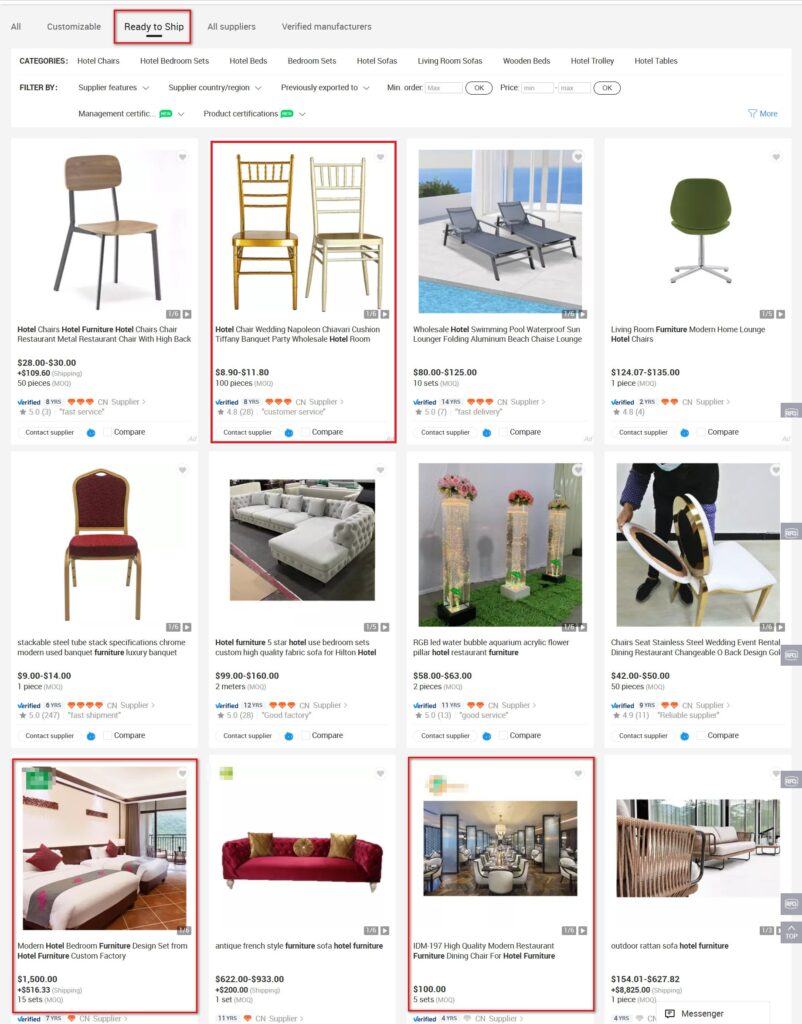
2) The price of furniture products on Alibaba
One of the first things you’ll look at is the price. Let’s check the tiffany chair in the first row of the above listing, and we can see an $8.9-11.8 USD price with MOQ 100 pcs. Please note that the price of furniture products on Alibaba is usually FOB China price. Check Barcelona chair price in below picture, and it is FOB price.
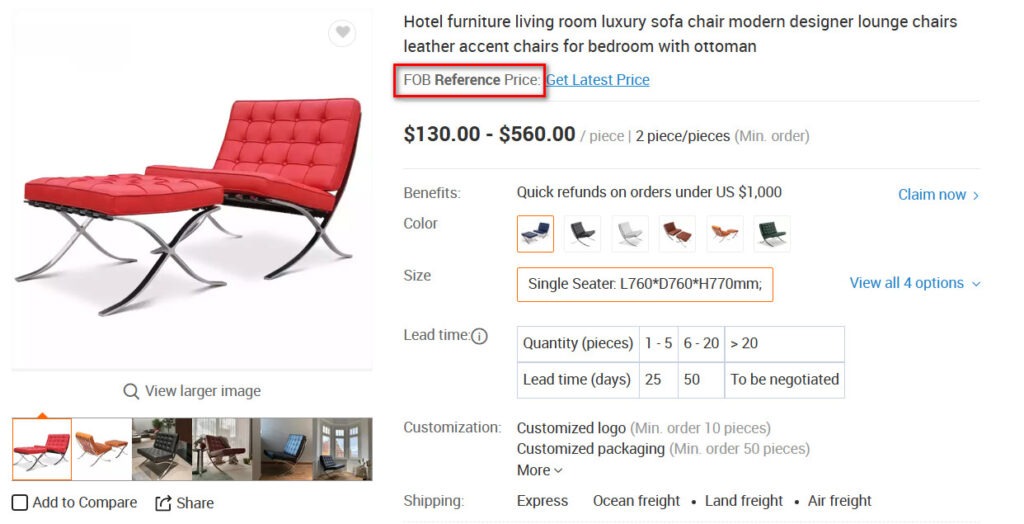
What is FOB? FOB is incoterm (International Commercial Term), which stands for Free On Board and means that the seller will pay all involved costs to get the product to the nearest or most convenient port.
This would be the most viable way to ship goods from Asia. The furniture buyer pays the cost of transporting the goods across the ocean to the final destination. Alibaba’s price is irrelevant here, as it is likely just a placeholder.
You can choose other incoterms such as EX-WORK, CIF and DDP, etc… We will introduce incoterms details in a later section.
3) Minimum Order Quantity (MOQ)
You can see a 100 pcs MOQ with price in the above tiffany chair picture. What is MOQ? The minimum order quantity (MOQ) is the smallest order the furniture manufacturer is willing to accept to start production. However, it’s important to note that this is almost always negotiable. In this tiffany chair example, the minimum order is 100 pieces. This usually means they have stock chairs or raw metal frames, and you can buy from 100 pieces. The bigger the furniture order, the lower the price. This 100 pcs MOQ can be less if you order other chair models from this furniture supplier. For example, 60 pcs tiffany chair, 70 pcs napoleon chair, 80 pcs ghost chair and 90 pcs tulip chair is absolutely acceptable for the supplier.
4) Payment Options on Alibaba
There are several standard payment methods, and each has pros and cons for both the buyer and the seller. The longer you work with a supplier, the easier it will be to deal with payments. If you have an established business relationship, you could ask that the following order be paid 100% on delivery (T/T). He can always say no, but if he agrees, this gives you financial liquidity.
Let’s take a look at the most common payment options and the associated risk level to you as the buyer:
a. T/T (Telegraphic Bank Transfer)
Risk Level For Buyer: Medium Risk
With a bank transfer, the furniture supplier will receive a deposit (down payment) before furniture manufacturing starts. Very important: if you agree to this payment, NEVER pay more than 30% upfront, and pay 70% balance upon the release of inspection and sea shipment documents. This payment method bears a medium risk to the buyer, and you can do little to get your money back if something goes wrong. But this payment method is relatively fair to both furniture buyers and sellers, so it is common in the business of importing furniture from China.
b. Letter of Credit (L/C)
Risk Level For Buyer: Very Safe
A letter of credit is safe for both parties. However, a letter of credit is rather complicated to issue through a bank, costs quite a lot of money, and is generally only recommended for larger purchases ($20,000 and above).
Some China furniture factories may refuse to use L/C as a payment method because they feel unsafe doing business in this way, then you can try a 30% deposit by T/T + balance payment with L/C.
c. Western Union
Risk Level For Buyer: Very Risky
Western Union should generally only be used when dealing with suppliers you trust. There is no guarantee that something will go wrong. It is suitable for small amount order, such as furniture samples.
d. PayPal
Risk Level For Buyer: Fairly Safe
PayPal is a popular payment method for buyers as it presents a much lower risk, ease of use, and generally good buyer protection. Although it’s a popular option with buyers, it’s less popular with suppliers due to difficulties in withdrawing money, high tax rates, and potential charge backs from less-than-honest buyers.
e. Escrow
Risk Level For Buyer: Very Safe
When using an escrow service, the buyer’s money is held by a third party and is only paid to the supplier after the buyer confirms satisfactory delivery of their order. Escrow is a relatively safe payment method for buying and selling online because it protects both the buyer and the supplier.
Generally, when you are just starting, you’ll probably want to look for or negotiate with suppliers to accept T/T, PayPal or some escrow service to give you the highest level of protection.
Please read our article How to Send Money to China for more details about payment options.
The next step would be to start communicating with the suppliers on Alibaba.
5) Contacting furniture suppliers on Alibaba.
Introduce yourself to each furniture supplier professionally, which usually looks like this. You can copy this section and use it for your first contact:
Dear…,
My name is ….. and I am the ….(Manager/President/Buyer etc.) of …. Limited/Inc.
We are a (fill in your company’s business, e.g., Furniture Importer/Buying Office/Furniture Wholesaler/Furniture Retailer/Interior Design) and are operating in (fill in your country).
You can also check out our website under www. …..
I am writing to you today to inquire about the furniture product I saw on your Alibaba shop/website/catalogue/exhibition.
The model number is…. (with pictures attached)
Could you please give me the following information: You can fill in the details in the attached quotation format or send me your quotation in the first step.
Unit price based on…. Pieces
Minimum Order Quantity:
Incoterm: FOB China (or EX-WORK / CIF…)
Production lead-time:
Payment terms:
I will evaluate it and get back to you as soon as possible.
If you have any questions, please don’t hesitate to contact me.
Thanks and best regards,
6) Tips when contacting furniture suppliers
Do this step with multiple furniture suppliers because it’s never good when you start to rely on just one supplier in China.
Do not mention that this is your first time contacting suppliers on Alibaba. It will probably give you a disadvantage in negotiating at a later point.
Make a folder on your desktop for easier reference and to keep track of your offers and suppliers. Name it “Alibaba” or “Sourcing” or anything you can easily relate to. Create subfolders for each supplier. In each subfolder, create folders such as: “quotation,” “supplier profile,” “furniture model pictures,” and so on.
We can provide simple offer sheets and supplier profile forms that you can include in your email when sending to the furniture supplier for the first time, send us an email or Whatsapp message.
Also, some suppliers may don’t read your entire email. So please point out the furniture model number or product images you are interested in and ask them to quote specifically.
Sometimes you will receive a simple email with a PDF catalogue asking which item you are interested in. It can be exasperating, but that’s the way it is sometimes. Politely reply that you are “looking for a specific quote on furniture model number…” or send the images and other details again.
You don’t necessarily have to use these forms to contact the supplier for the first time. Many will not fill it in because it takes time, especially when you only need quotations for one or two furniture products. Try to make it simple and efficient.
However, if you have narrowed down your suppliers, you should ask them to fill it in for your records. Keeping clean records is crucial to your follow-up.
7) Ask questions and follow up.
As you begin narrowing down furniture suppliers, make sure to ask a lot of questions about their business and their furniture products:
Ask for a copy of their business license and company and factory standards (for example, ISO-9001).
Ask which laboratories/third-party companies they work with. If they only work with Chinese test or inspection companies, be cautious.
Ask for photos of the furniture factory or company presentation (PDF/PowerPoint) and furniture showroom details.
Feel free to ask for whatever makes you feel more comfortable doing business with them. Ask who their customers are and where they are located. If they don’t have any customers in your country, be careful, as they might have no experience dealing with your country’s regulations and standards. Ask about them. If they already work with a competitor or an industry similar to yours, it’s a good sign that they can fulfil your requirements.
Send a vendor profile so the furniture suppliers can fill in their details. They should cover production capability, how many workers/staff/engineers, main customers, certifications, company turnover, etc.
8) Get Furniture Samples / Prototypes
Before you invest any significant amount of money into the inventory, you need to get furniture samples to check and verify quality. But mock-up furniture is not cheap, and the shipping of furniture prototypes is troublesome, we will explain the furniture sample process in a later section.
9) Sounds fishy.
Finally, if something is too good to be true, it usually is. Be aware of prices, suspicious payments, or communication that doesn’t seem right. It’s never too late to cease communication and look for another supplier.
Tip: When asking your questions and formatting your emails to suppliers, it’s best to work with paragraphs or bullet lists of requests so that it is easy for them to understand your requirements and needs. Make the furniture supplier answer each of your “bullet questions.”
10) Requesting a quotation.
Requesting a quotation/price, also referred to as an RFQ (Request For Quote), is a relatively simple process. However, taking a few extra minutes to plan your email can significantly affect the number and quality of replies you receive.
For example, you can send more details such as design pictures, drawings, BOQ (Bill of Quantity), and FF&E (Furniture, Fixtures, and Equipment), which makes the process easier and more efficient.
Here again, is a simple form for an RFQ:
Dear…,
My name is ….. and I am the ….(Manager/President/Buyer etc.) of …. Limited/Inc.
We are a (fill in your company’s business, e.g., Furniture Importer/Buying Office/Furniture Wholesaler/Furniture Retailer/Interior Design) and are operating in (fill in your country).
You can also check out our website under www. …..
I am writing to you today to inquire about the furniture product I saw on your Alibaba shop/website/catalogue/exhibition.
The model number is…. (with pictures attached)
Could you please give me the following information: You can fill in the details in the attached quotation format or send me your quotation in the first step.
Unit price based on…. Pieces
Minimum Order Quantity
Incoterm: FOB China (or EX-WORK / CIF…)
Production lead-time
Payment terms
I will evaluate it and get back to you as soon as possible.
If you have any questions, please don’t hesitate to contact me.
Thanks and best regards,
11) Negotiating with China furniture suppliers
Once you have begun conversations with multiple suppliers and have a good idea about their prices, MOQ, and payment terms, you can start negotiating with them.
Here are some tips on negotiating:
It is a given that once you place your order, you negotiate the price, whether you are below the supplier’s MOQ or not.
Use the price you originally quoted and decrease it by 20%. Give this target price to the factory and let them know you would like to order with your (20% reduced) price. In most cases, the supplier will not agree to your new target price, but he may reduce it by another 5%.
In 80% of cases, the suppliers will give you a further reduction on their original quoted price unless your quantity is very low.
Also, mention to them that this will be the first trial order and that if it is successful larger orders will follow.
12) Weighing Your Options
Once you’ve narrowed it down to a select few furniture suppliers and manufacturers in China, you’ll want to weigh all your options. Bear in mind it’s not always about the price and quantity. It’s also a gut feeling that you should get when communicating with a supplier. Did he reply eagerly and quickly? Did he follow up in detail or send fragments to your questions?
If you have the feeling it’s difficult now to communicate, imagine how it would be to work with him once the order is placed. Make sure you eliminate the suppliers with the least potential and the most issues now!
13) Conclusion for Alibaba
Sourcing a reliable furniture supplier from Alibaba can be a great experience. Following the above steps and tips should get you working with a reliable and good furniture supplier. Don’t just settle on your first supplier or only one supplier. Keep your options open and order multiple quotations and furniture samples/prototypes.
Made in China Furniture Sourcing
Made in China is very similar to Alibaba. It’s just a bit smaller and less known. Made in China focus on industry products (e.g. machinery, furniture and lighting) B2B, all the suppliers are from China, and it attracts buyers interested in importing products from China. The suppliers on Alibaba may not come from China, and Alibaba is more synthetic than Made in China.
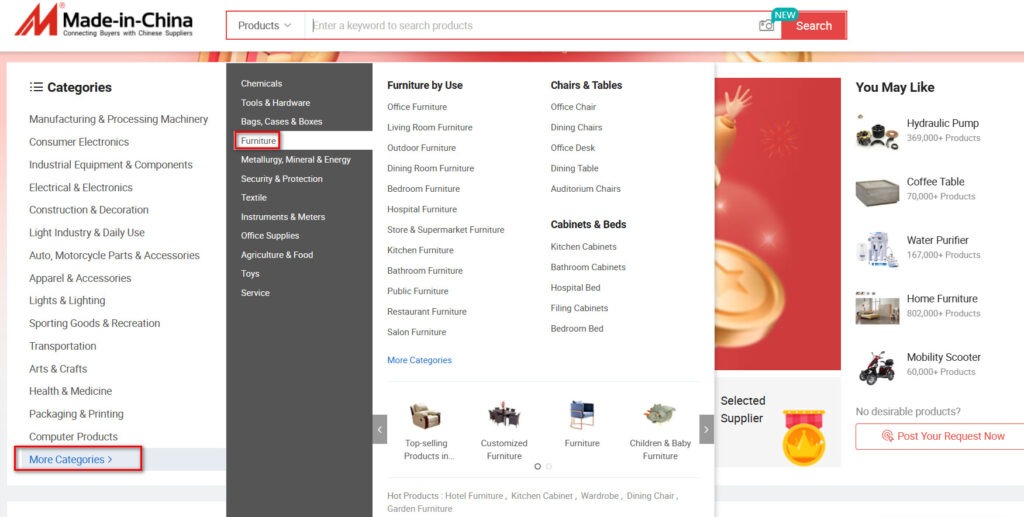
The rules of Made in China are simple, not as many games (it means suppliers need to pay more to get more views and customers) as Alibaba, and Made in China does better optimization on furniture products, so many China furniture manufacturers and suppliers pay to be a member of this platform. If you can’t find a furniture product on Alibaba, try it on Made in China.
Start by registering and creating a profile as a furniture buyer. It’s the same process you followed with Alibaba.
Once you have completed your registration, you can start looking for furniture products and suppliers.
Once you have inputted your furniture product search on Made in China, you will see many China furniture manufacturers and their products. Let’s try “egg chair”.
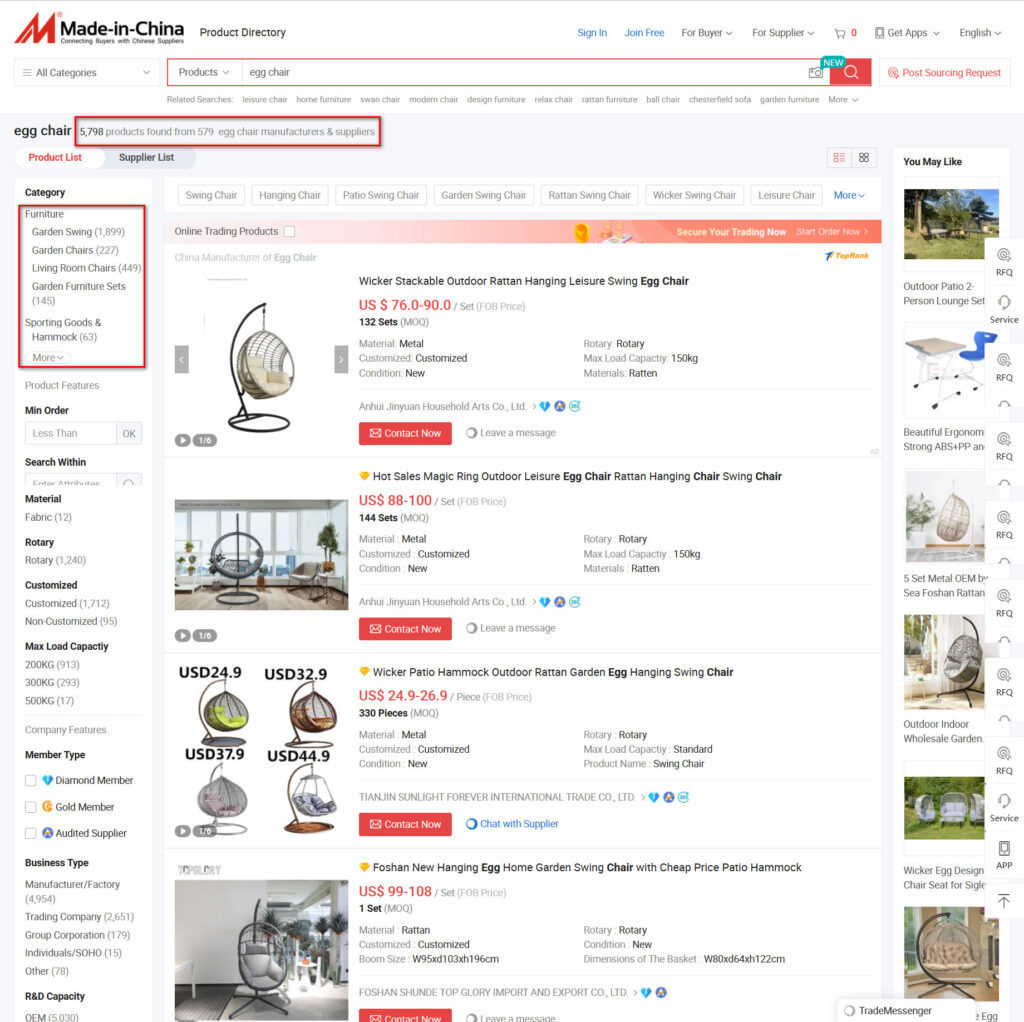
You can see that 5,798 products found from 579 egg chair manufacturers & suppliers in China! On the right, they have an excellent tool similar to Alibaba’s. You can see if the supplier has been verified, what is his member type (diamond, gold and audited supplier), what is his business tyoe (manufacturer, trading company, SOHO), and so on.
You can filter by “Audited Supplier”, “Manufacturer/Factory,” “City,” and more. Again, it’s very similar to Alibaba.
Start your furniture product search as the previous chapter. We will not repeat this process.
Ordering furniture samples and prototypes from China
You shouldn’t place a large order without seeing a furniture sample or product. You or your customer need to check furniture prototypes for shape, size, material, function, durability, package, and more.
Furniture samples are more important in custom furniture projects; we will go into more detail later.
Furniture sample is not free.
When ordering furniture samples, most China suppliers will charge you. And the majority of those will charge 100-200% on top of the regular price for large quantities because making a furniture sample is more “costly.” For example, sometimes it is hard to find raw materials to make a 1pc chair sample, and most material suppliers would not like to do the work for 1 pc even if we pay more because it is troublesome and the profit is not good.
Either way, this is an investment you need to make. But don’t worry; most China furniture suppliers will refund you the sample cost on the first official order. So make sure to remind the supplier of this when you place a large order later.
Steps of ordering furniture samples
When you order a sample from the factory, make sure of the following steps:
- Send an email inquiry with a furniture sample list
- State the details of the furniture sample (size, material, color, package, etc.)
- Confirm the days it costs with the supplier
- Make payment for the furniture sample (usually 100% upfront if the amount is small)
- Check the samples in China or arrange to ship them
- Tell the supplier that you will deduct the sample charge from your first order
How to ship furniture sample
Compared to shoes, bags, phones, and rings, most furniture items are large and heavy. They are not suitable for air transportation by DHL or FedEx, the cost would be very high, and these furniture items may be easily damaged during air freight. But it would be OK if it is urgent to get the furniture samples and you can accept the expensive cost. Just ask the supplier to use a good quality package with a wooden frame outside, then check the pictures to confirm and ship these furniture samples.
Some customers would choose to ship furniture samples by sea. How? They can ask the suppliers to send furniture samples to other China suppliers, and they ordered goods there so that they can put these furniture samples in that container and they ship them together. We call this FCL(Full Container Load) shipping.
You may ask: What if I don’t have any containers to ship in China? Then you can try LCL shipping. LCL stands for Less than a Container Load. Your furniture samples would be shipped with others’ goods in one container, and there would be many kinds of charges in both China port and your local port under LCL shipping. Remember to confirm all details with your freight forwarder before making a decision.
Some furniture buyers may choose to check furniture samples in the supplier’s factory directly, there would be no shipping trouble in this way, and furniture buyers can visit the factory, check products in the showroom, discuss furniture samples and future cooperation with manufacturer or supplier face-to-face, it is suitable for large order because the cost of visiting China is not cheap.
Furniture sample invoice
Ask the supplier to state: “samples of no commercial value” on the sample invoice packed with the furniture sample. This way, customs will see this is a sample not to be resold and should not be taxed. Ask the supplier to lower the value of the sample cost on the invoice. But it shouldn’t be an amount that is too low; if it is, it may sound not credible. For example, if you order a chair sold at 60 USD, then the declared amount should not be lower than 20 USD.
Incoterms in importing furniture from China
The Incoterms rules or International Commercial Terms are how you pay and deliver your goods. Please look at this very detailed entry on Wikipedia: http://en.wikipedia.org/wiki/Incoterms. Here we introduce 3 common incoterms in importing furniture from China.
1) FOB China Port Price
When any furniture supplier from China gives you a quotation, it’s usually FOB (Free On Board).
FOB means that he produces and ships the items once manufactured to the nearest port. His responsibility ends there, and you (or your logistics provider) take care of the rest. This is the most used option when importing from Asia. Many other options may suit you more, depending on your budget and experience in shipping. See the Incoterms above for more options. Discuss with your supplier or forwarder how you would like your goods shipped.
Usually, the furniture factories and suppliers would choose the nearest port to make FOB price, but there are many ports in China, and not all ports are the same. Take Foshan City (China) as an example, it has Foshan Port, but it is small and not convenient, so many Foshan furniture manufacturers and exporters choose Shenzhen Port for shipping containers. What you can see in their quotation is the FOB Shenzhen price.
2) EX-WORK China Price
Please note that if you only order furniture products in small quantity (such as furniture samples, mock up room furniture), and the volume is not enough for a 20GP container, it is troublesome to do FOB incoterm. The supplier usually would make EX-WORK China price, which means you need to pay the total amount before your shipping agent collects goods from this supplier, not balance payment against copy of B/L (Bill of Lading) in FOB China term.
EX-WORK is the lowest price in suppliers’ quotations because they don’t need to afford port and shipping freight. But you need to arrange collecting from the furniture factory and afford the port charge, your shipping agent would charge you more.
3) CIF Your Port Price
Some furniture buyers may ask for CIF (Cost Insurance and Freight) price when sending RFQ to us, usually, they don’t buy a lot from China, and they don’t want to spend lots of time finding a shipping agent to discuss details, so these buyers & importers need us to deliver containers directly to their port, they would find a local import agent to do the rest job.
CIF price is higher than FOB price because the seller needs to afford the sea freight, but you will save time and energy to deal with logistic companies.
Don’t use CIF if you regulary import from China and want to control more in the business, try to find several China shipping agents, then send instructions to them when you need to ship containers from China.
The longer you work with a supplier, the easier it will be to deal with payments. If you have an established business relationship, you can ask that the next order should be paid 100% on delivery (TT). He can always say no, but if he agrees, this gives you financial liquidity.
How to Build a Relationship with China Furniture Suppliers
Why build a relationship
Your furniture suppliers are critical to your import from China business’s success. The better you treat them, the more they will continue business with you and give you better service or performance than their other customers.
As professional furniture manufacturers, we would give better treatment and pay more attention to a customer’s order when we are treated fairly.
Are we just waiting for your business? We usually have other customers waiting to ship their furniture products. And we are more likely to prioritize customers with whom we make more margin and ones that are easier to deal with.
We had furniture buyers who were very aggressive and tried to squeeze every cent out of us. It was tough to handle these buyers, and they often couldn’t find a suitable supplier for long-term business. Even after orders were fulfilled, these buyers would often come afterward and try to claim money for a “faulty” furniture product when there was actually nothing wrong. Many times just for the sake of it, they would try to get money out of us. This is not the way we want to work with.
A fair and respectful relationship to help each other.
Try to make a fair, respectful, and trusting relationship with your furniture suppliers in China. You’ll get what you put in. Want cheap? Get cheap. It all depends on what type of furniture product you are looking for. If you are in for fighting with competitors on Amazon or eBay or bidding on contract furniture projects, you are probably looking for the cheapest. But don’t be surprised when your products are of poor quality, and you get bombed with bad reviews on Amazon/eBay or need to pay a lot of compensation to replace low-quality furniture products. If you want to stand out from your competition, you might as well start with good quality products, perhaps at a higher price. Sure, once in a while, you look for the absolute price entry product, but be prepared for the quality issues.
Also, don’t try to gain something from squeezing your supplier out of every cent when he struggles to fulfill the order and pay his workers. What if you want to place a reorder or need a favor one day? He may not be around anymore, and you will be stuck.
When a supplier is in trouble because of another customer, you may want to help him. Say he has produced a lot of furniture products that another customer canceled, you can try to refer some customers to him. But be careful of stock furniture in China; we will go into details later.
This kind of relationship is very valuable for you. If you help your China supplier, he may offer free furniture samples, discounts on your next order, and so on.
Six rules to having a great relationship
We would say there are six rules to having a great relationship with your supplier:
- Make sure there are mutual benefits
- Respect each other
- Be fair to each other
- Trust one another
- Support each other
- Help each other
Don’t break business rules.
Having said all that, it doesn’t mean you should trust your furniture suppliers blindly. An old Chinese saying: Don’t harm others, but be aware of being harmed by others.
You still need to have a few control mechanisms, such as inspection, checking reports and certificates he sends, and not easily accepting price increases. If they are reasonable issues, they can be discussed, but you can research the eligibility of the supplier’s claim. Make your own decision, and don’t let the supplier lead you.
Furniture sourcing/trading companies in China.
Many buyers who import furniture from China only want to find factories/manufacturers, not furniture sourcing or trading companies in China or Hongkong because they think the furniture factory price must be best. China furniture sourcing or trading companies also buy products from factories/manufacturers, prices from these companies must be high, which would make buyers’ businesses little profit.
Is it true? Of course not.
Advantages of furniture sourcing/trading companies in Asia
Why should you hire a furniture sourcing company or do business with a furniture trading company? Here are the advantages:
1) Better price (for some customers/projects)
You may think that strange, why is furniture sourcing or trading companies will have a better price? Let’s explain it with an example.
If you have a furniture store that only sells one furniture product: Togo sofa, and you need to import it from China with the quantity of five 40HQ containers every month, in this case, you want to find a professional sofa factory in China as the supplier, because many small and medium-sized China furniture factories are only focusing on one single type of furniture products, to ensure the quality with competitive price.
Some furniture sourcing or trading companies may also buy Togo sofa from this sofa manufacturer. Since you can order five 40HQ containers of Togo sofa every month (large quantity), the sofa furniture factory can give you a better price than other furniture sourcing or trading companies.
However, if you don’t have any furniture store and are planning to open four new restaurants, you would need different types of furniture products for the restaurants, such as square dining tables, rectangle dining tables, dining chairs, banquette seating, sofas, coffee tables, and reception desks, etc. You will also need other relative products such as lighting, lamps, tableware, carpets, curtains, decorations, kitchen equipment, etc.
The quantity of all these products is not large (maybe 2X40HQ container max), and you will not buy these products every month, so you will not get the best price even if you find real China restaurant furniture manufacturers, why? You haven’t yet done business with these suppliers, and they don’t know you, why should they give you the best price for the first time?
Suppose you are not satisfied with the price from suppliers. In that case, you can consider doing business with furniture sourcing or trading companies for this project because they help many customers to buy restaurant furniture and relative products. They are quick to make a quotation for all products with competitive prices, and all suppliers would give them a better price than you because they may have been doing business for many years.
2) Save your time and money
As you can see from the above example, if you buy from furniture sourcing or trading companies, you don’t have to spend lots of time contacting many China factories or suppliers, and your company doesn’t have to hire several purchasing staff and train them on product knowledge such as types of wood for furniture, yes, you pay a commission to the sourcing company or let the furniture trading company makes a profit from your order, but you save more time and money. That’s why many big brands cooperate with sourcing companies in Asia.
3) Best service
Many China furniture factories are doing business in both export and domestic furniture market, especially furniture factories with certain brand influence. When the export furniture business is not good (affected by the COVID-19 pandemic, or the war between Russia and Ukraine, or the exchange rate between RMB and USD, etc.), they will focus on the China domestic market. If your furniture orders are not in large quantity or not high profits, the factory will say “Sorry but we are busy” …
But furniture sourcing or trading companies will not easily reject you. They only do export business, so they value every customer. You can get good prices and services from these companies even if your order is small or troublesome.
4) Easy to control the quality and delivery time
Furniture sourcing or trading companies are basically in China or HK, so it is convenient to go to the furniture factories in China to check the quality and urge the furniture suppliers to deliver on time. Some companies would even arrange for QC to live near the factory for a while to check furniture manufacturing progress at any time and communicate with the factory when problems are found to ensure that the delivery time will be on time. You can’t fly to China and then check quality between different furniture factories every month, so it is very convenient to give this job to furniture sourcing or trading companies.
5) Less financial pressure on payment methods.
Some China furniture factories are not flexible on payment methods, and they can only accept T/T and refuse L/C or D/P. One reason is that they are not familiar with L/C or D/P, another reason is that manufacturers usually have pressure on stock and capital, they want to receive payment as soon as possible, and this may make you more financial stress.
But the furniture sourcing or trading company does not have this problem, most of them can accept L/C or D/P, and you can buy different types of furniture products with one L/C, no need to make T/T payments to many furniture suppliers, so that you have much less pressure on the capital, and the risk is also low.
6) Easy to expand your business
Furniture sourcing or trading companies often sell various furniture and accessory products with good prices and services. If you work with a company a few times and feel satisfied, you can promote other products from this company, and it is much easier to expand your business.
Disadvantage of furniture sourcing/trading companies in Asia
You need to be careful when doing business with new furniture sourcing/trading companies in China, and many scammers register these types of companies and then rent a small office, the cost is very low, then they can start to cheat customers’ money by all means. Usually, they would disappear several months later.
We have some clients that get scammed, one of them lost more than $100,000, and it is almost impossible to get the money back.
Here are some tips for identifying fake furniture sourcing/trading companies:
- Check their company profile carefully, you can send it to your trusted China supplier to check if there is Chinese on the files.
- Beware of very cheap offers. There would be a problem if one company gave a half price compared to all other suppliers’ quotations, this company would want to get your deposit and then run away.
- Try small order first, see the performance of the furniture company, you will only lose a little if something is wrong.
- Try to use L/C payment for large orders, it is much safer than T/T. If they can’t accept L/C, there may be problems.
Welcome to contact us if you have any furniture sourcing inquiry, you can send email / Whatsapp message, or call us directly.
Incoterms 2020 in importing furniture from China
If you’re involved in international trade and either has to sell goods to a buyer based in a foreign country or need to import daily fast-moving consumer goods such as furniture from abroad, you must have heard the word incoterms.
Most China furniture suppliers would also specify “Incoterm is EX-WORK Foshan / FOB Shenzhen /CIF Mombasa” etc. on their quotation, you might get confused if it is the first time you are importing furniture from China, here we do a brief introduction to incoterms 2020.
What are Incoterms?
Incoterms stands for international commercial terms, a set of terms published by the International Chamber of Commerce and outlines the risks, costs and liabilities applicable to buyers and sellers in international import & export business.
Incoterms are three-letter terms followed by the appropriate place of destination or delivery. For example, EX-Work Yiwu, FOB Shanghai and CIF Dubai.
Even though incoterms are not mandatory terms that must be included in a commercial invoice. Incorporating them into a contract is recommended by simply referring to them. Normally such reference is made like this:
The furniture goods will be delivered CIF Long Beach, USA incoterms 2020.
You have probably seen several proforma invoices with similar provisions and wished you understood what those three letters mean.
Main elements of Incoterms
To better understand how incoterms work, we will start by looking at the main elements applicable to Incoterms. Depending on the type of incoterms, they consist of some (or all) of the following elements:
- Loading on track
- Carriage to the port of export
- Exports formalities
- Unloading at the port of export
- Loading at the port of export
- Transit to the port of import
- Unloading at the port of import
- Import formalities
- Loading at the port of import
- Carriage to the destination
- Cargo insurance
The main difference between the various types of incomes is based on who between the seller and buyer is responsible for each of the above elements. It will be covered in detail with examples later.
To better understand how incoterms work, they can be divided into two groups:
- Rules for any mode of transport
- Rules for sea and inland waterway Transport
For Incoterms 2020 Rules to apply, the following reference structure must be used:
[Relevant Incoterms Rule][Port, place or location] Incoterms 2020
Now let’s discuss each of the incoterms in more detail.
EXW – Ex Works (named place of delivery)
EXW rules favour the seller at the maximum level possible. If you are new to the import furniture business as a buyer, the furniture supplier or manufacturer will likely want to sell you the furniture products under Ex Works incoterm.
Under EXW, the seller only should provide the buyer with the goods that are properly packed at a certain place. Most of the time, the goods under EXW are provided at the seller’s factory or warehouse. Thus, a reference to EXW in the contract is provided like this:
EXW Seller’s warehouse at Shunde Area, Foshan City, Guangdong, China – Incoterms 2020
Once the buyer has accepted the goods, all costs associated with the delivery of the goods to the final destination (such as import and export duties and transportation costs) will be the buyer’s responsibility. That is why EXW rules are favoured by the sellers the most.
New furniture buyers or importers often fall into this trap if they do not have a legal background, and dishonest sellers take advantage of it. They simply tell one thing verbally and do not provide more information about EXW.
So, what are the possible main risks that a buyer or importer can face?
- Problems with collecting and delivering the goods
- Difficulties with paying customs and other relevant duties in a foreign country.
- Additional costs associated with hiring a legal professional or customs broker in a foreign country.
It is also possible that under such a contract, the buyer will have to pay 100% advance payment for the goods, and if dealing with a dishonest seller, the buyer can lose both the goods and the money.
If you have a furniture project and need to import furniture from different China furniture factories separately to make one or several 40HQ containers full, then you most likely need to do EX-WORK price with these furniture suppliers and have them deliver to your China warehouse or container loading location when all furniture products are ready, most China furniture manufacturers will deliver for free if it is not far away.
Please note that under the EXW terms, you need to arrange full payment before furniture suppliers deliver the goods, you can’t make a balance payment against a copy of B/L (usually under FOB incoterm), and you can’t do LC payment either, because furniture supplier does not control the bill of lading and other documents under EX-WORK incoterm.
FCA(a) – Free Carrier (named place of delivery – seller’s premises)
FCA is a slightly better option compared to EXW. Under this option, the buyer does not simply take the goods from the seller’s warehouse. Incoterms 2020 introduced two options to FCR Rule.
Under this option, the seller is responsible for uploading the goods to the transport vehicle provided/arranged by the buyer. This is a good option considering that the seller is likely to be better qualified to upload the goods and has the necessary experience and tools to do that.
Moreover, all the costs and risks associated with uploading the goods to the provided transport vehicle are related to the seller.
So, if the goods get damaged while loading, the seller will be responsible for the same.
So, if a contract provision states something like:
FCA (a) Seller’s Factory, Guangzhou, China – Incoterms 2020
Then the buyer will have to provide a vehicle to the said factory, and the seller will upload the goods to the said vehicle. Once the goods are uploaded, the seller will complete its obligations under the contract, and all risks associated with the goods will pass to the buyer accordingly.
FCA(b) – Free Carrier (named place of delivery – not seller’s premises)
Under this option, the buyer still does most of the transportation-related actions. However, the seller delivers the goods to a third party or the buyer’s premises.
Under FCA (b), the seller uploads the goods to a transport vehicle at its premises and then delivers them to a cargo terminal.
Still, this option can be considered if a buyer regularly purchases from one country, has many different suppliers in the same country, and, as a result, operates its warehouse there.
If that is the case, a buyer will likely have qualified employees and the necessary tools to unload the goods once they have been delivered to the warehouse by the seller, which consequently reduces the risks associated with unloading the goods at its facility.
Nonetheless, the buyer will still face the difficulties associated with customs clearance of the goods in a foreign country as with EXW and will likely incur additional costs associated with hiring a legal professional or customs broker in a foreign country under both FCA options.
However, if the buyer has a presence in a foreign country (as discussed above), the difficulties related to knowledge of local legislation and customs will be reduced.
For example, suppose you import many furniture products from China every month, and most furniture suppliers are in Foshan City, China. In that case, you can rent a warehouse in Foshan and then do FCA prices with these furniture suppliers, ask them to send your furniture products to this warehouse, and then arrange a container (sea shipping), truck, or plane to deliver furniture products to the destination.
CPT – Carriage Paid to (named place of destination)
Under CPT, the key difference is the moment the risks and expenses associated with carriage pass from the seller to the buyer.
Normally, CPT is similar to FCA, and the key point here is transfer of the goods from the seller to the carrier. However, the carriage may be performed by several carriers.
Let’s check an example.
A furniture retailer in Ulaanbaatar, Mongolia, purchases 100 pcs office chairs from a furniture factory in Anji, China.
These chairs will be delivered from Anji to Ulaanbaatar in stages by road.
Firstly, a third-party carrier engaged by the seller will deliver the goods from Anji to Erenhot, China.
Afterwards, a third-party carrier engaged by the buyer will deliver the goods from Erenhot, China, to Ulaanbaatar, Mongolia.
Under the CPT terms, the risks associated with the goods will pass from the seller to the buyer at the moment they are transferred to the first carrier in Anji, China.
Nonetheless, the cost for transportation is paid by the seller until the goods are delivered to the buyer in Ulaanbaatar, Mongolia.
In the above example, the wording in the contract will be made like this:
CPT Buyer’s warehouse, Ulaanbaatar, Mongolia – Incoterms 2020
Under the CPT, the seller must cover not only transportation costs but also all relevant customs fees and duties, including the costs in the buyer’s country.
However, the risks associated with any damage caused to the goods while in transit will be the buyer’s responsibility.
CIP – Carriage & Insurance paid to (named place of destination)
CIP is very similar to CPT, with the key difference being the provision of insurance coverage by the seller. However, the insurance coverage provided by the seller under CIP is minimal.
So, if the buyer is willing to have additional insurance coverage, it must either procure itself or negotiate with the seller provision of additional insurance coverage.
Under CIP, it is very important to understand what the insurance policy provided by the seller will cover.
However, such insurance may provide only the minimum required coverage. Since the risks may be passed to the buyer during the early stages of transportation, the insurance may not cover all possible scenarios, and the buyer may still face damages.
DAP – Delivered At Place (named place of destination)
DAP is an option that favours the buyer rather than the seller. Under DAP, the seller must arrange for transportation of the goods to an agreed point where the seller or its representative will unload the goods.
For example, a restaurant in Paris, France, signs an agreement with a furniture manufacturer based in Foshan, China, and the parties agree that the shipment of dining chairs will be delivered by air under DAP terms.
So, the wording in the contract related to delivery will be something as follows:
DAP Charles de Gaulle Airport, Paris, France – Incoterms 2020
Under the said terms, the seller will be responsible for loading the chairs, paying all customs and other duties in China and delivering the chairs to Paris, France, to the buyer ready to be unloaded.
Once the goods in the above example are at the Charles de Gaulle Airport, the buyer will be responsible for unloading them and paying off all relevant customs and other duties applicable under French Law.
At the moment the buyer accepts the goods and starts unloading them, the seller will be deemed completed its obligations and consequently will not be responsible for any damage to the goods as a result of their unloading.
However, certain risks must be considered under DAP. For instance, if the seller has delivered the goods to the agreed point, but the buyer failed to accept and unload them on time, the goods get damaged (a likely outcome with food products).
Nonetheless, determining such damage may be difficult and complicated, especially if no special conditions covering such an issue were provided in a contract between the parties.
DPU – Delivered at Place Unloaded (named place of destination)
DPU is very similar to DAT discussed in the previous section, with the main difference being the seller’s responsibility to unload the goods.
Meanwhile, DPU is the only term that requires the seller to unload the goods.
As with DAT under DPU, the seller will be responsible for loading the goods, paying all customs and other duties in the country of origin and delivering the goods to the named place of destination to the buyer and unloading them.
When the goods are delivered to a major international ports/transport terminal, the place of destination under DAT and DPU must be defined as precisely as possible since some ports are quite large:
Port of Shanghai, China
Port of Jebel Ali, UAE
Memphis International Airport, USA.
DDP – Delivered Duty Paid (Named place of destination)
DDP is quite similar to DAP and DPU described earlier.
However, the key difference here is related to the payment of customs and other relevant duties.
DDP is the only rule under which the seller is responsible for paying all import and export duties. Thus, if the goods are delivered under DDP terms, the buyer will be in a more favourable position than the seller.
Nonetheless, the seller is not responsible for insuring the goods for pre-carriage and main carriage.
The main issue the seller must consider when agreeing to deliver the goods under DDP terms is that customs procedures vary from country to country.
So, if the seller is unfamiliar with customs clearance in any given country, it is better to use other incoterms than DDP terms. Otherwise, a delay in clearing the goods through customs at the destination country may breach the seller’s obligations under the relevant commercial invoice.
Therefore, as far as the seller is concerned, it is advisable not to use DDP and have the buyer perform the customs clearance of the goods, which is likely to be more familiar with relevant procedures.
FAS – Free Alongside Ship (named port of shipment)
Under FAS, the seller must perform export clearance of the goods and deliver them to a specific place next to the ship so that the goods can be loaded accordingly. So, the wording in the contract must be as follows:
FAS Pier 7, Port of Rotterdam, Netherlands – Incoterms 2020
The goods must be delivered at an agreed date or time. The main point here is that the ship must be at the named port simultaneously for the goods to be considered delivered “alongside”.
If FAS is used in the import & export business, then the seller will be responsible for performing customs clearance procedures and paying duties related to the import only.
The risk will pass from the seller to the buyer at the moment the goods are delivered alongside the ship, and the seller will not be responsible for any damage to the goods that may happen afterwards.
The buyer will be responsible for loading the goods and paying for the costs afterwards.
FOB – Free On Board (named port of shipment)
FOB is one of the most common terms when importing furniture from China. Under FOB, the seller must clear the goods through customs for export, deliver them to the named port, and load them onto the designated vessel.
Once the goods have been loaded onto the ship, the risk of any further damage to the goods will pass from the seller to the buyer. The key point here is the delivery time agreed upon in the contract.
The buyer in London, UK, signed a contract with a sofa manufacturer in Guangzhou, China, to purchase a chesterfield sofa and agreed for the goods to be delivered under FOB Huangpu Port of China.
The agreed time was 10 November 2022, 15:00
The seller delivered the goods to the Huangpu Port of China at 14:00 to have enough time to properly load the goods onto the nominated vessel.
However, the ship nominated by the buyer arrived late and instead arrived the next day at 17:00.
While the goods were waiting at the Huangpu Port of China, it started to rain early in the morning on 11 November 2022, and as a result, some chesterfield sofas got damaged. When the ship nominated by the buyer arrived, the buyer refused to accept the damaged sofas.
In the above example, the seller is not responsible for the sofa damage since the risk passed to the buyer at 15:00 on 10 November 2022, when the seller delivered the goods to the Huangpu Port of China.
CFR – Cost & Freight
CFR is quite similar to FOB described earlier as far as the following elements of the carriage are concerned:
- Customs clearance at the country of origin
- Loading of the goods
Under CFR, the risk also passes from the seller to the buyer at the moment the goods are loaded onboard the vessel.
However, the key difference here is that the seller must arrange and pay for the delivery of the goods to the named destination port.
Even though the seller arranges and pays for the delivery of the goods, it is not responsible for any damages caused to the goods while in transit.
Since the risk passes to the buyer at the moment the goods are loaded onboard the ship. It may insure the goods while in transit, considering that the buyer is not the one delivering them.
CIF – Cost, Insurance & Freight (named port of destination)
CIF is very similar to CFR, with the key difference being the seller’s liability to insure the goods while in transit.
However, even though the seller must insure the goods while in transit, only the minimum coverage must be provided.
Therefore, the buyer must consider all risks associated with the delivery of the goods under the CIF Rule and, if needed, procure additional insurance.
Moreover, under CIF and CFR (described earlier), the buyer is still responsible for informing the seller about the destination port. Otherwise, if the seller does not have information about where exactly to deliver the goods and, as a result, fails to deliver the goods, the buyer will be responsible.
Therefore, instead of stating in the contract:
CIF – Port of Manilla, Philippines – Incoterms 2020
CFR – Port of Piraeus, Greece – Incoterms 2020
And then inform the seller later on where exactly to deliver the goods within the ports. It is better to have the same port of destination mentioned in advance.
CIF – Pier 5, Port of Manilla, Philippines – Incoterms 2020
CFR – Pier 3, Port of Piraeus, Greece – Incoterms 2020
However, it will not be possible sometimes. For instance, if the delivery takes a long time (like a couple of months), it will not be practicable for the buyer to inform the seller in advance of the exact location within the port where the goods must be delivered. Unless, of course, the port of destination is not a busy hub, and there are only a couple of places where the goods can be delivered.
In the carriage of goods by sea, CIF is the one that is the most beneficial for the buyers.
Even though the risks for the goods under CIF pass to the buyer from the moment the goods are loaded onto the vessel, the seller is still obliged to insure the goods while in transit until delivery to the named destination port.
Summary and advice of incoterms
Now You have a basic understanding of the main differences between various Incoterms rules used in international trade. Here are our sugguestions:
- If you import lots of goods from China every month (for example, more than 3 containers), and the number of China suppliers is small, each supplier’s goods can be at least one full container, you can try to find a long-term cooperation shipping agent in China, then do FOB China incoterm with your China suppliers.
- If you import lots of goods from China every month (for example, more than 3 containers), but the number of China suppliers is large, and each supplier’s goods are small in scale, then you can do EX-WORK incoterm with these suppliers, and try to find a long-term cooperation shipping agent in China, then pay for this agent to collecting all goods and putting them together in a warehouse for loading container.
- If you occasionally import goods from China, for example, once a year, about 2-3 containers, then you can do CIF with China suppliers, and let them arrange sea shipping to your port. You do the rest job.
- If you are busy and your China supplier has a good custom clearance & shipping company partner in your country, you can also do DDP incoterm with your China supplier, then sit in your office and wait for the goods.
Foreign exchange rates in import business
When you import furniture from China, you have to make payments to your furniture suppliers in China. Most China furniture manufacturers and factories accept payment of US dollars, Euros, and CNY (China’s local currency, also called RMB and Chinese Yuan)., You can pay USD directly if your import business is in the United States, but you have to convert AUD (Australian dollar) to USD before paying to China supplier if you import furniture from China to Australia, how much AUD should you prepare for the USD 20,000 proforma invoice? There is a foreign exchange rate involved, and it will affect both you and your China supplier’s profits, so here we make a brief introduction about foreign exchange rates.
Introduction to exchange rates
What is the foreign exchange rate, and why is it required?
An exchange rate is required when an amount designated in one currency is needed to be converted into an equivalent amount in another currency. The exchange rate is the price quoted in one currency for one unit of another currency—for example, 1 US dollar = 7 Chinese Yuan.
Every country has its currency, as we know it well. When money is transferred from one country and received in another country, the exchange rate is used if the currencies of both countries are different.
Money is transferred from one country to another for many reasons. Some examples are:
- Personal purposes include medical expenses, education costs, gifts, or family support.
- Person traveling from one country to another need local money at the destination.
- Payment for importing goods or services from an entity in a foreign country.
- Loan taken from an entity in a foreign country.
Example of foreign exchange rate
ALHAFAWA TRADING ENT in Riyadh intends to buy some Tolix Marais A Chair from China. It has already selected our company as the furniture supplier and signed a USD 20,000 contract.
But SAR (Saudi Riyal) is the local currency in K.S.A., so how does ALHAFAWA TRADING pay for these chairs in US dollars? It would send an instruction to its bank (e.g., National Commercial Bank) to convert the SAR in its account into USD based on an exchange rate of 1USD=3.75SAR, it would cost 20000*3.75=75000SAR to buy USD 20,000, then National Commercial Bank sends this USD to our company account in Bank of China by T/T, and our bank would convert it into CNY (China local currency, also called RMB, Renminbi, Chinese Yuan) after receiving this payment, let’s say the exchange rate is 1USD=6.73CNY, we finally get 20000×6.73=134600CNY.
Now one important thing to be noted here is that the exchange rate used by the National Commercial Bank and Bank of China in the above sample will change every day and will also be different for different kinds of transactions.
But not all money transfers between two countries would use an exchange rate. For example, suppose Les Canailles in Paris wants to buy some Thonet 14 Chairs from Thonet Germany. In that case, Les Canailles will not have to consider the exchange rate when arranging payment because France and Germany use the same currency – Euro.
Now remember one thing: Money can be converted from one currency to another even if there is no remittance or transfer from one country to another or within the same currency zone.
Therefore, it is possible that you could have a conversion even without an international fund transfer.
In very simple terms, the exchange rate can be defined as how many oranges I need to give to get one apple.
Let’s see, the weight of the apple is 100 grams, and the orange is 25 grams, so it would be very easy to see that 1 apple = 4 oranges. But it is not so simple. An Apple has to be available first to get in exchange for oranges, and if the apples are in short supply and have much demand, I may have to give more oranges to get one apple.
The quality of oranges will also play a role in this.
Demand–supply situation decides the exchange rate
The price changes every day and every minute in the market based on the demand–supply situation of the two currencies.
Like gold, silver, metals, agricultural commodities, shares of publicly listed companies, etc., which are traded in the market and their prices fluctuate, currencies are also traded.
When there is a high demand for a particular foreign currency in the market, and the availability of that foreign currency is limited, the exchange rate will tend to be high.
On the other hand, if the availability of a particular foreign currency is high and the demand for that currency is not much, the exchange rate will tend to be lower.
Basic principles of exchange rate
There are 8 fundamental principles of the foreign exchange market.
Principle #1
- Foreign Currency does NOT mean only physical currency notes and coins.
- Foreign Currency means the currency unit of a foreign country.
- Foreign Currency is a “commodity” that can be thought of with the “purchasing power” of the local Currency.
Principle #2
“Foreign Exchange” means any item denominated in a foreign currency, such as:
- Physical Currency Notes & Coins
- Traveller’s Cheques, Drafts & Money Orders
- Wire Transfers
- Trade Bills & Invoices
- Account Balance, Deposits & Investments
- Amounts payable or receivable
Principle #3
Only licensed agencies can buy and sell foreign exchange!
Principle #4
Licensed Agencies are:
- Banks & Financial Institutions
- Debit, Credit, Pre-Paid, and Travel Card Companies
- Travellers’ Cheque Companies
- Money changers, Travel, and Foreign Exchange Bureaus
- Approved hotels and retail stores
Principle #5
Every licensed agency cannot undertake every kind of foreign exchange transaction.
The license terms will specify the type of transactions an agency can do.
Principle #6
The exchange rate applied for converting one Currency to another depends on the type of transaction and the type of agency that is doing the transaction.
Principle #7
There are two basic rates – “Buying Rate” and “Selling Rate.” The words “buying” and “selling” are always used from the licensed agency’s point of view.
Principle #8
Non-bank licensed agencies depend on the banks for both supply and disposal of foreign exchange; hence, their exchange rate offering is driven by the banking system.
Types of Exchange Rates
There are 5 types of foreign exchange rates, different exchange rates are offered by the banks or other licensed agencies for different transaction types due to the costs involved.
1.TT selling and TT buying rates
If amount conversion from one currency to another is done at the remitting bank, then TT selling rate is used. If conversion from one currency to another is done at the receiving bank, then TT buying rate is used.
Telegraphic Transfer selling or buying rate is used in electronic funds transfers for non-trade purposes.
2.Bill selling and bill buying rates
Bill selling and bill buying rates are used for commercial transactions involving the import & export of goods and services between two entities located in different countries. The seller of goods or service provider will normally send a commercial invoice or pro forma invoice to the purchaser for payment. Using this invoice as proof of the requirement to make payment, the purchaser would approach his bank to send the money in foreign currency.
On the other hand, the seller of the goods or service provider, on receiving the payment in foreign currency, may approach his bank to convert the amount into local currency and submit a copy of the invoice as proof of commercial transaction. Commercial transaction involves more work and effort for the bank.
3.TC selling and buying rates
TC selling and buying rates are used for the purchase of travelers’ cheques by tourist and business travelers, their traveler’s checks issuing company sells foreign currency-denominated traveler’s checks, but the purchases are usually against the local currency. For this, TC selling rate is used.
4.DD selling and buying rates
DD stands for demand draft. In many countries, it is also called a cashier’s check pay order or a banker’s check. It is a popular form of making payments in foreign currency for various purposes, such as payment of university fees, participation in a conference, professional expenses, and purchases of goods and services.
DD is usually issued by a bank or a financial institution. The issuing bank applies the DD selling rate when a demand draft is issued in foreign currency. When a demand draft is issued in foreign currency is presented for payment. The paying bank applies its DD buying rate if the amount is to be converted to another currency.
5.FCN Selling / Buying Rate
FCN stands for foreign currency north. FCN selling or buying rate is used for the purchase and encashment of physical cash in the form of currency notes by tourists and business travelers.
The bank or authorized agency sells foreign currency notes to the purchaser, usually against the local currency. For this, FCN selling rate is used.
When the purchaser of the currency notes encashes it at a bank or any authorized agency, an FCN buying rate is used to convert the foreign currency amount to the local currency at the destination.
Basic exchange rate risks
There are several risks associated with foreign exchange business, but this article will cover only the two primary risks associated with this field.
1. Price risk or exchange rate risk
Fluctuation in the value of one currency against another currency is a risk similar to the stock market risk. The price of a company’s shares may fall, leading to erosion in the value for the shareholder. In the same way, Foreign exchange holders may experience a decline in the value of the assets held in foreign exchange if the price of that particular foreign currency falls.
The risk can also affect businesses adversely.
Imagine a company that has to import material, machines, or technology from another country to run its operations. The payment for the import is to be made in a foreign currency. If the price of the foreign currency vis-à-vis the local currency goes up, the company’s cost will go up and cause an erosion in profits or even cause a loss.
On the other hand, a company that exports its products to other countries can be adversely affected if the exchange rates fall, i.e., the local currency becomes stronger. The company will receive a lesser amount in local currency terms.
The risk can affect individuals also. Imagine a family that has planned a vacation to a foreign country, an increase in the exchange rate could increase the family’s expenses in their home currency terms and throw their budget out of gear.
2. The convertibility risk or exchange controls risk
A particular foreign currency may suddenly become unavailable in the market, or trading of that currency may suddenly stop. This would throw all plans and business transactions lined up in that currency out of gear. Such a scenario can occur in the following situations.
- a. War
- b, Economic crisis
- c. Global Financial and Trade Sanctions
- d. Voluntary decision to make currency “non-convertible.”
- e. Imposition of limits on foreign exchange transactions.
Imagine we (in China) are doing business with a customer in Russia, which suddenly comes under war with Ukraine in February 2022, leading to restrictions on remittances USD in Russia. Our payments receivable from this Russian client may get stuck and lead to losses.
Another example, the Lebanese Central Bank announced on January 31, 2023, that Lebanon would adopt a new fixed exchange rate from February 1, the official fixed exchange rate of LBP (Lebanese pound) to the U.S. dollar will be adjusted from 1507.5:1 to 15000:1. At this rate, the LBP will be devalued by 90%, and importers will have to pay 900% more LBP to buy USD than before to pay for their goods. Many China suppliers exporting goods to Lebanon will face the risk of their customers abandoning the goods and not receiving the final payment.
What is hedging?
We learn how fluctuations in the exchange rate can cost losses to individuals and businesses. Wouldn’t it be wonderful if the exchange rate for a transaction planned in the future was known in advance? A company would know how much local currency it has to be for purchases of imported material and accordingly fix the selling price of its products at a profitable level. If the company knew how much it would earn in local currency amount from the export of its products, it could be fixed the sale price profitably.
It is possible to book an exchange rate for a transaction planned for a future date. So whatever the actual exchange rate may be on the day of the transaction, the company which has opted for booking will get the predetermined exchange rate on its transaction. This pre-book rate is called the contract rate.
Using the facility of contract rate to protect oneself from fluctuations in the exchange rate is known as hedging,
Now protection from fluctuating exchange rates may also be available to a business. For example, a company that has bought imported material and export products can use its foreign currency earnings from export sales to be for its import purchases without having to convert the amount to the local currency. This is known as natural hedging.
Forward rates are quoted in terms of 1 month forward, 2 months forward, and so on. The maturity or delivery date is calculated as several months from the SPOT date. Accordingly, the premium or discount on the spot rate is applied to arrive at the forward rate.
Apart from this, there are other ways of hedging against foreign exchange risks through contract rates such as Options, Futures, Swaps, Forward Rate Agreements, Derivatives, and more.
The above-contracted rate agreements between the bank and the customer can be canceled before maturity.
Summary of foreign exchange rates
Now you should have a basic understanding of the foreign exchange rates. We hope it can be helpful when you import furniture from China.
Calculate your cost
This part makes or breaks your import from China business. You must calculate all your costs for the furniture product to make sure you can turn a profit.
Import duty can be calculated in different ways. You can take the buying price from your China furniture suppliers and add 20-30% on top, regardless of which China port you import it from. This gives you a rough idea of what your landing price will be.
This rule applies to first-world countries or areas like the US, Europe, Hong Kong, and Singapore. Many second or third-world countries are not so open to importing and put a high percentage of duties and taxes on top of import products to protect the local industry.
Many first-world places even have 0% duties and taxes to encourage imports. This applies especially to “green products” that are sustainable and help reduce energy or waste. A good example is sustainable furniture with nearly 0% tax and duties.
Let us look at an example of how to calculate your cost:
Your product is tulip chair (designed by Eero Saarinen), and you want to import it from China to Los Angeles, USA. The incoterm is FOB Shanghai, China, and unit FOB price is USD 35.
First, you need to calculate the shipping costs. The size of tulip chair is 48*39*78cm, and we usually make a knock-down package to save space in container, so one 40HC container can load about 880pcs tulip chairs. That’s the order quantity in this example.
Then you can go to https://www.icontainers.com/ and calculate the sea shipping cost for one 40HC container from China to Los Angeles, USA.
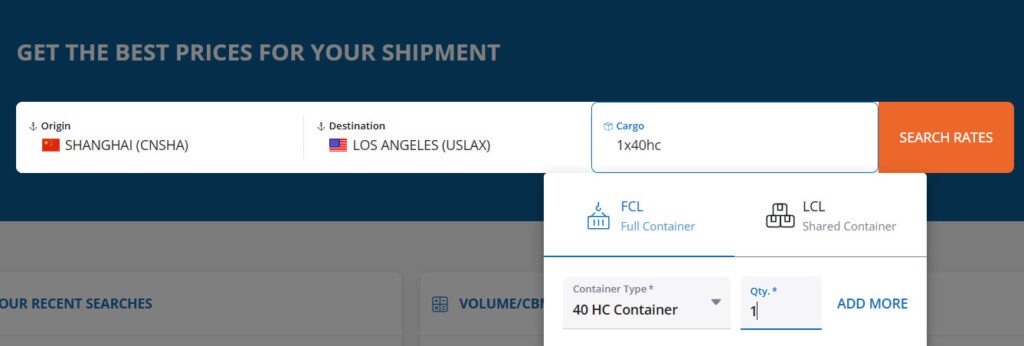
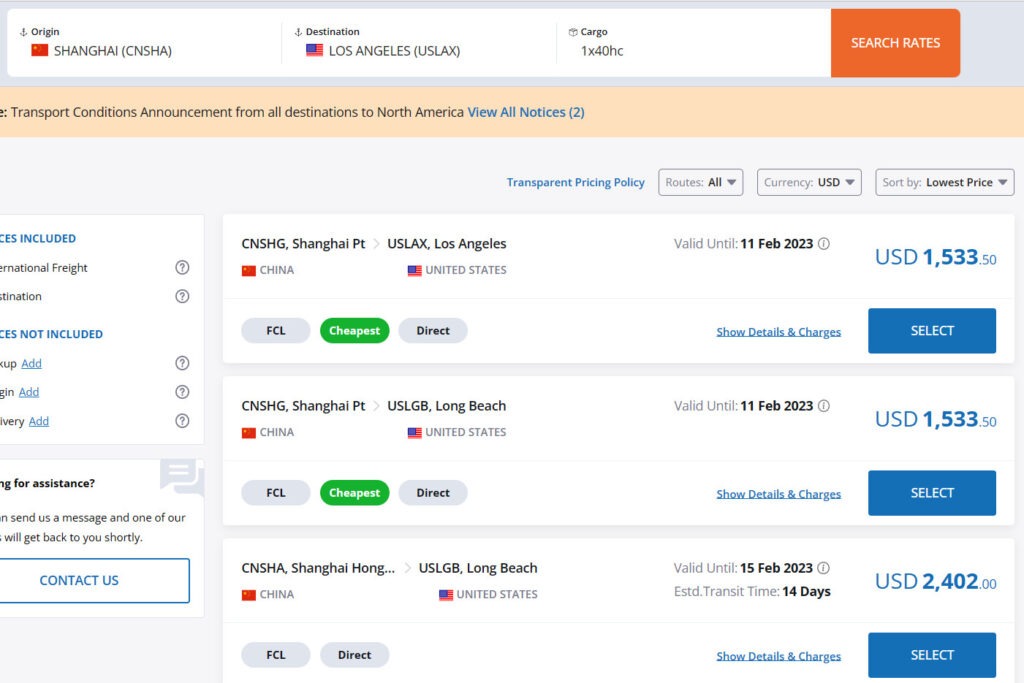
You can see that the lowest price is 1,533 USD, but it may be tricks from these China shipping agents (it would be unavailable when you send an inquiry, then they recommend another option with a higher price), most of the quotations are about 2,500 USD, so let’s make the shipping cost for one 40HC container be 3,000USD.
Now, go to https://www.simplyduty.com/ (5 free calculations per day)
Just input details such as country of import from, country of import to, currency, product description (use “tulip chair” directly or use its HS code 9401.80), product value, product quantity, shipping cost, and insurance cost. The shipping cost is 3,000 USD. Insurance is usually 1% of the total product value (about 300 USD in this example), then press calculate.
Here we go, you have all costs listed. Wow, 0% duty & tax!
And, there would be a merchandise processing fee of 0.3464% of the FOB value applied for imports if it exceeds 2500USD, with a minimum of 25USD and a maximum of 485USD. It is 107 USD in this example (35*880*0.3464%).
Please note that your shipping provider may add a handling fee.
So essentially, you have the following import costs:
- 3,000USD Shipping
- 300USD Insurance
- 30,800USD Product Value
- 107USD Customs & duties
TOTAL: 34,207USD
That’s 38.8 USD per tulip chair (we have 880 pcs). It would give you an excellent span for margin. Just check the price of tulip chair on Amazon, about 110 USD for one tulip chair, you may want to compete with Amazon at a price 100 USD.
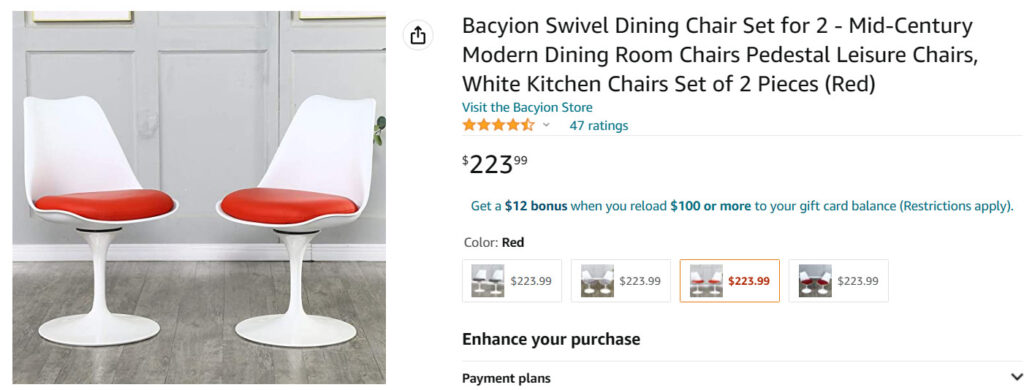
Obviously, you have to calculate your domestic shipping and storage or fulfilment costs on top, but you should have a fair margin with which you can sell this product.
We calculate another 20% in storage and packing costs because furniture is large and heavy, and you need a larger warehouse with more workers to deal with them. Now you end up with 46.6 USD on this tulip chair. To be safe, you can round up to 48 USD. That gives me a potential margin of 52 USD per item (100 USD minus 48 USD). Total sales will amount to 88,000 USD (100*880) if you sell everything.
In other words, after you have deducted all your costs and investment, you can make a gross profit of 53,793 USD. You could take that 53,793 USD and invest in your next furniture project and build an even larger product portfolio.
You may also contact your logistics provider if you aren’t sure about logistics or duty costs. We will explain this in the next chapter.
Contact China shipping agents and get a quote
The shipping cost on icontainers.com is for reference only, and we suggest you do not place an order on this website. It is only a platform, and the operation would be more complicated than you contacting a China shipping company or forwarder directly. You will also get a better offer from logistics providers in China. Before sending RFQ (Request For Quotation) to shipping agents in China, we first need to understand some basic knowledge about sea shipping containers.
Why sea shipping container?
Most furniture products are heavy and packaged in large volumes. The best way to ship the furniture you import from China is by sea in containers. The cost is cheap, and the furniture is less likely to be damaged in containers.
Why not ship furniture by air? Furniture products are usually placed at the bottom of all goods in an aeroplane. They can be easily damaged even if we use wooden frames to protect the packages. The most important point is that air freight is much more expensive.
Let us take the eames lounge chair with stool as an example.
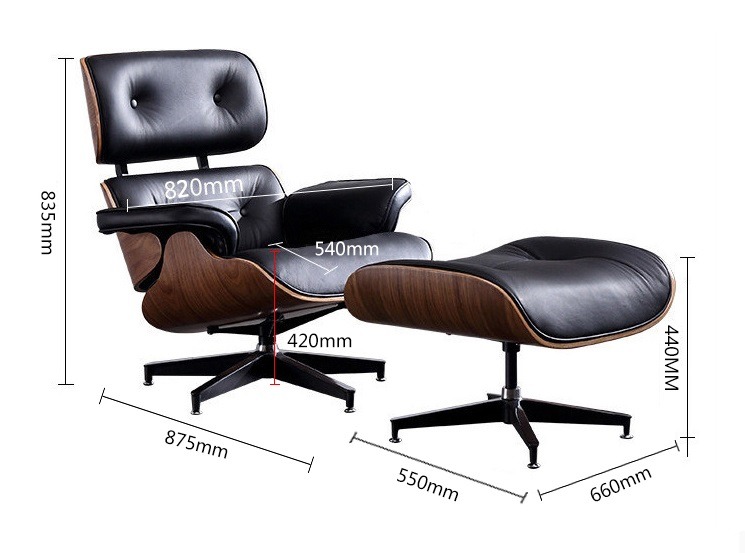
The package of eames lounge chair with stool is 1 set in 1 carton box with a size of 110 * 92 * 60cm and a gross weight of 28 kg. 110 sets can be loaded in one 40HC container, the sea shipping cost from China to Los Angeles is about 3,000 USD (February 2023), so the sea shipping cost on one set eames lounge chair is about 28 USD (3000/110).
Now let’s look at air freight. We use the same carton box size and gross weight as the above example, from Shenzhen (China) to Los Angeles in the USA. UPS agent in China quotes the air freight of 1,030 USD for ONE carton box. Although it is a door-to-door price, it is still very expensive compared to the 3,000 USD sea shipping cost for 110 sets eames lounge chairs.
(H3)Types and sizes of containers for furniture
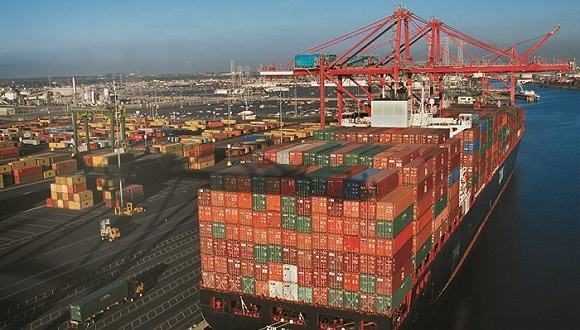
There are many types and sizes of containers for shipping all kinds of goods from China. Three types of containers are widely used if you import furniture from China: 20’GP (General Purpose Container), 40’GP (General Purpose Container) and 40’HC (High Cube Container). Their differences in size can be found in the following table.
| 20’GP Container | 20’GP Container | 40’GP Container | 40’GP Container | 40’HC Container | 40’HC Container | |
| imperial | metric | imperial | metric | imperial | metric | |
| External Length | 20’0″ | 6.058m | 40’0″ | 12.192m | 40’0″ | 12.192m |
| External Width | 8’0″ | 2.438m | 8’0″ | 2.438m | 8’0″ | 2.438m |
| External Height | 8’6″ | 2.591m | 8’6″ | 2.591m | 9’6″ | 2.896m |
| Internal Length | 19’4″ | 5.710m | 39’3″ | 12.032m | 39’3″ | 12.000m |
| Internal Width | 7’8″ | 2.352m | 7’8″ | 2.352m | 7’8″ | 2.311m |
| Internal Height | 7’10″ | 2.385m | 7’10″ | 2.385m | 7’10″ | 2.650m |
| Door Width | 7’8″ | 2.343m | 7’8″ | 2.343m | 7’6″ | 2.280m |
| Door Height | 7’5″ | 2.280m | 7’5″ | 2.280m | 8’5″ | 2.560m |
| Internal Volume | 1,169 ft³ | 33.1 m³ | 2,385 ft³ | 67.5 m³ | 2,660 ft³ | 75.3 m³ |
| Maximum Gross Weight | 66,139 lb | 30,400 kg | 66,139lb | 30,400 kg | 68,008 lb | 30.848 kg |
| Empty Weight | 4,850 lb | 2,200 kg | 8,380 lb | 3,800 kg | 8,598 lb | 3,900 kg |
| Net Load | 61,289 lb | 28,200 kg | 57,759 lb | 26,600 kg | 58,598 lb | 26,580 kg |
FCL (Full Container Load)
FCL means that you order a full container from one supplier or several suppliers only packed with your furniture products. For example, A FURNITURE SHOP in Australia wants to import 135 pcs togo sofas from us, total CBM is 66 m³, which is just one full 40HC container, so it is FCL.
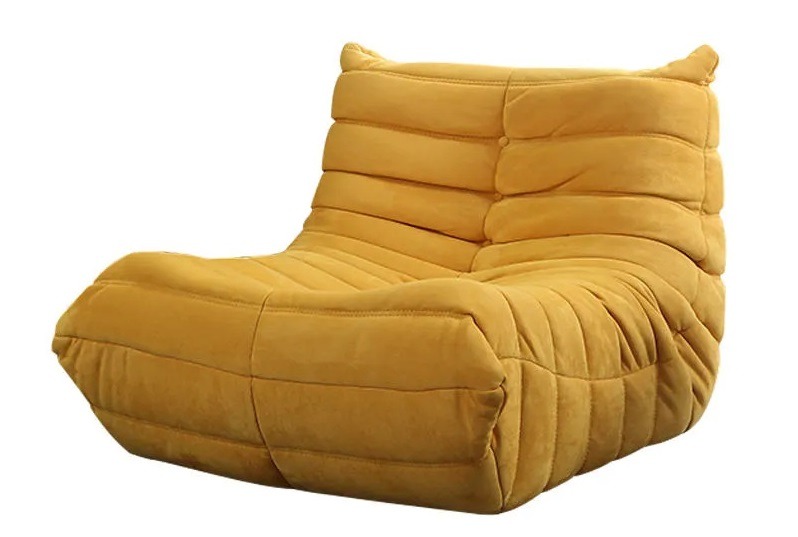
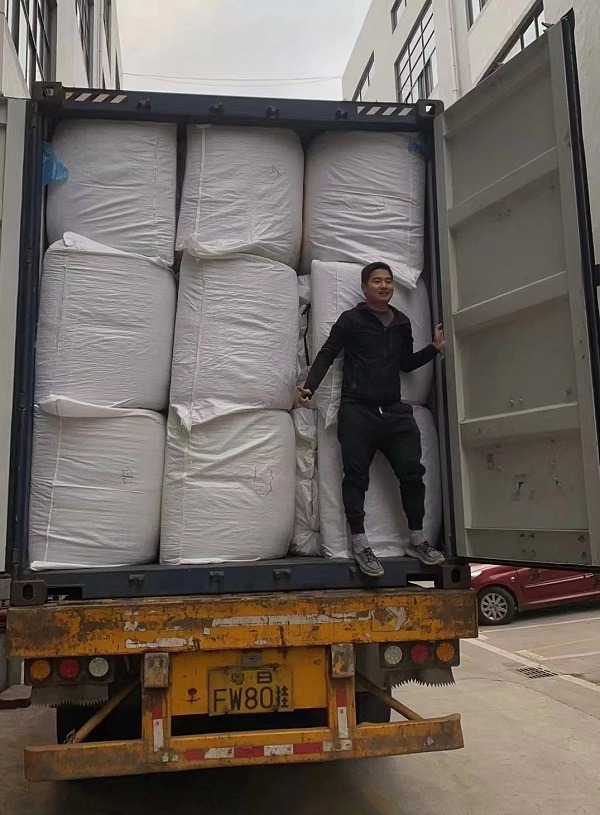
There is only one supplier in the above example, so it is easy to deal with, but things would get complicated if you buy furniture products from different China suppliers and try to put them together to make one full container.
For example, A FURNITURE SHOP company in Australia purchased 50 Barcelona chairs from our company, the packing volume is 35 m³. This customer also purchased 67 togo sofas from another China supplier ABC company at the same time, the packing volume is 33 m³, These sofas and chairs can fill exactly one full 40HC container, the customer can Let his China shipping forwarder arrange container to our factory to load Barcelona chairs first, and then go to ABC company to load togo sofas, or directly ask ABC company to send these 67 togo sofas to our company to load container together.
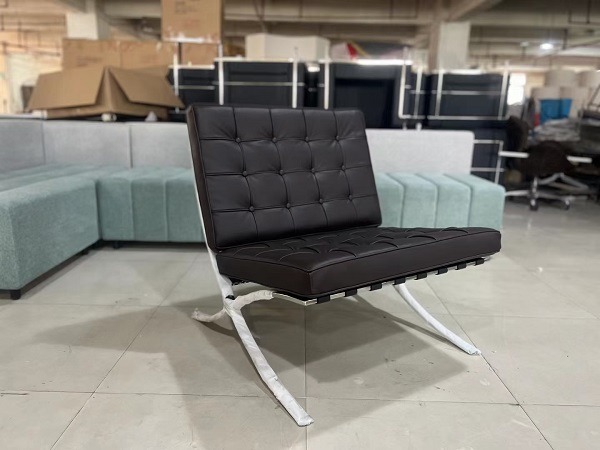
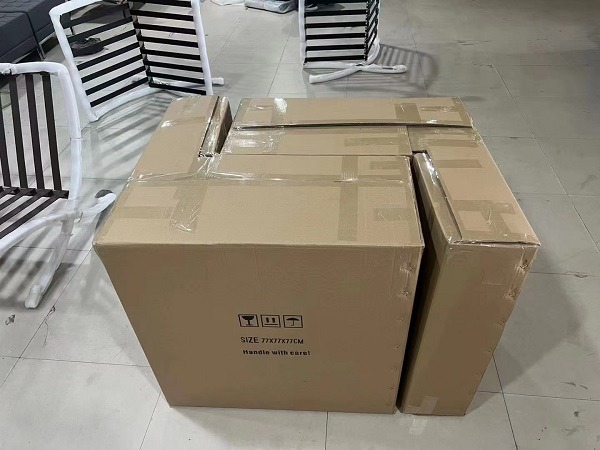
The distance between these suppliers cannot be too far if you do FCL in this way because the territory of China is vast. The logistic cost would be high if the supplier is far away from the place of container loading, most suppliers would not afford this cost if you do EX-WORK incoterm. And there is a risk of damage to the furniture products in long-distance transportation. The furniture suppliers also need to ensure that the packing volume data on the packing list is accurate. Otherwise, there would be space waste in the container, or some goods can not be put into the container, which is a big problem.
The incoterm is usually FOB or CIF in FCL if there is only one supplier, and it would be better to do EX-WORK incoterm with each supplier if you ordered furniture products from different China suppliers and try to make them together for one full container, most suppliers would deliver goods for free if the container loading place is not far away (for example, all furniture suppliers are in the Foshan City of China, and the place of loading is in Shunde Area).
The suppliers would charge extra freight if they are far away from the place of container loading, you can ask them to add this cost to the proforma invoice, but remember to tell them where the container would be loaded before confirming the order.
LCL (Less than Container Load)
You ordered some furniture in China, the total volume is less than a full container loading, and it will be shipped with other goods (may not be furniture) from other buyers and importers in one container. This is LCL.
Usually, we don’t recommend to do LCL shipping method because it is troublesome and expensive, you don’t know what kind of goods are together with your furniture products in that container, and in most cases, the furniture items would be at the bottom because of large packing volume so that it would be easily damaged, or even missing.
You can make one full 20GP container at first, it is not a hard thing considering that the packing volume of most furniture items is not small. For example, the CBM of one L shape sofa might be 2-3 m³, 10 sets would make one 20GP container full, and you can even add some side tables (knock-down package). You can also buy some other products such as lighting, carpet, ceramic etc. and put them in the container to make it full.
How to find a shipping agent/forwarder in China
It is simple, go to Google or Bing or ChatGPT, type “China shipping agent” or “China shipping forwarder”, then click search, you can find many shipping agents and forwarders in the search result.
If you don’t want to spend time in it, here we list several options: visit their website and call or send an email. You can also contact us, and we will gladly make a quotation.
| Shipping Company Name | Website |
| ATLANTIC Forwarding Group | https://www.atlanticforwarding.com/ |
| TOLL Group | https://www.tollgroup.com/ |
| U-Freight Ltd | https://ufreight.com/en/index.php |
| Kuehne+Nagel | https://home.kuehne-nagel.com/ |
| MSC Shanghai | https://www.msccargo.cn/ |
| MBS Logistic | https://www.mbslogistics.com/eng |
Details you should prepare
Here are some details you need to provide before contacting your logistics company in China:
- Container volume (your goods in volume, calculated by the supplier)
- Quantity of each furniture model
- Total gross weight and net weight of these furniture products
- Number of SKUs (how many different furniture products)
- The material of these furniture products
- Delivery points and address (pick up and destination address)
- Contact information of your furniture suppliers (name, phone number)
If you are unsure of any of the above information, ask your furniture supplier to provide this. They usually have good experience dealing with logistics companies. Every factory should have a “shipping department” or shipping agent in China.
After you have received the logistics provider’s quote, you should also ask your factory’s logistics provider for a quote to compare and make sure you are not getting ripped off, and your prices are competitive. Take the shipping costs into consideration with your customs and tax duties, and you have your landing price.




